SITXGLC001 Research and Compliance with Regulatory Requirements
VerifiedAdded on 2023/05/30
|33
|8095
|312
AI Summary
This article provides information on research required for legal compliance, sources of information to keep up to date with compliance, laws and licensing requirements, systems or procedures to ensure compliance, and consequences of non-compliance with environmental law, among others.
Contribute Materials
Your contribution can guide someone’s learning journey. Share your
documents today.
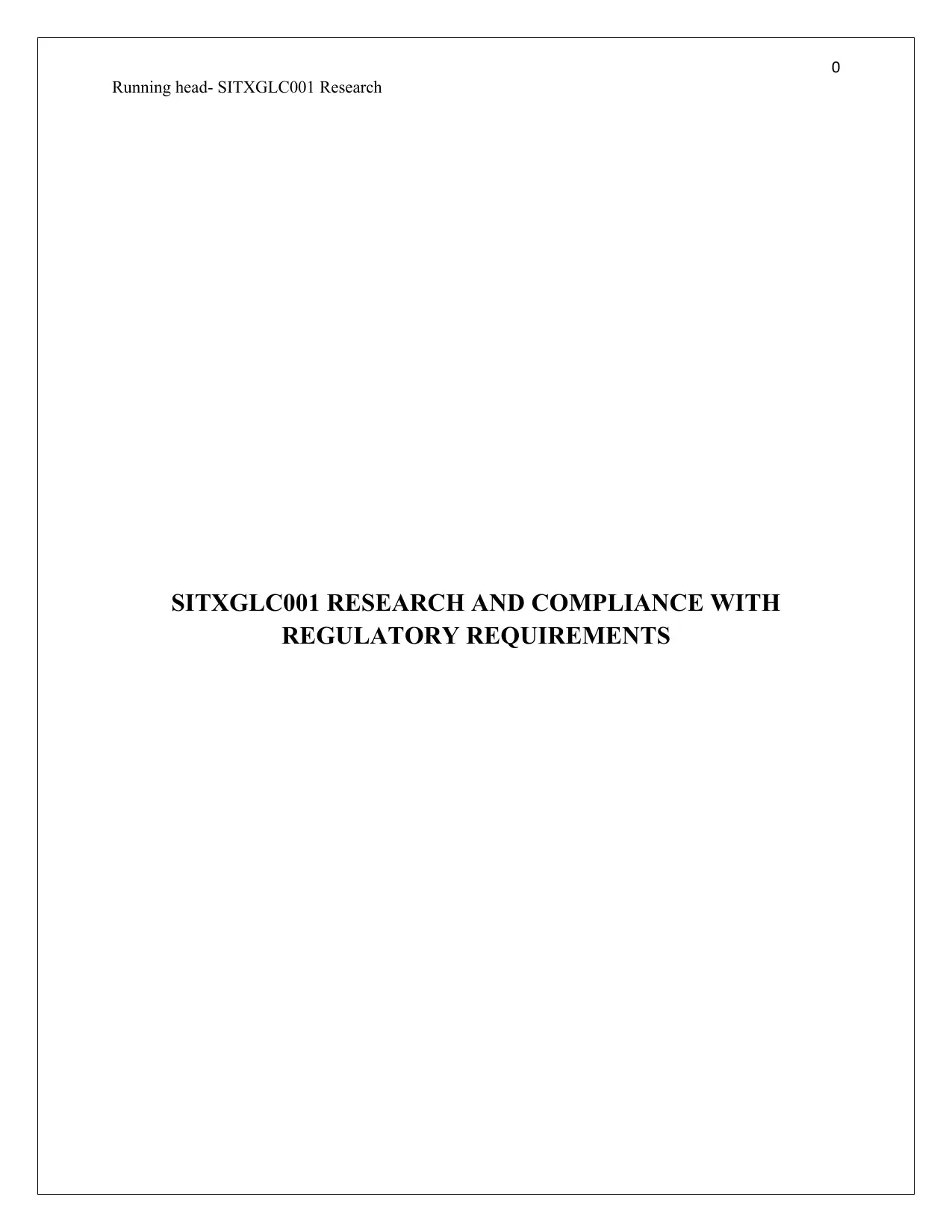
0
Running head- SITXGLC001 Research
SITXGLC001 RESEARCH AND COMPLIANCE WITH
REGULATORY REQUIREMENTS
Running head- SITXGLC001 Research
SITXGLC001 RESEARCH AND COMPLIANCE WITH
REGULATORY REQUIREMENTS
Secure Best Marks with AI Grader
Need help grading? Try our AI Grader for instant feedback on your assignments.
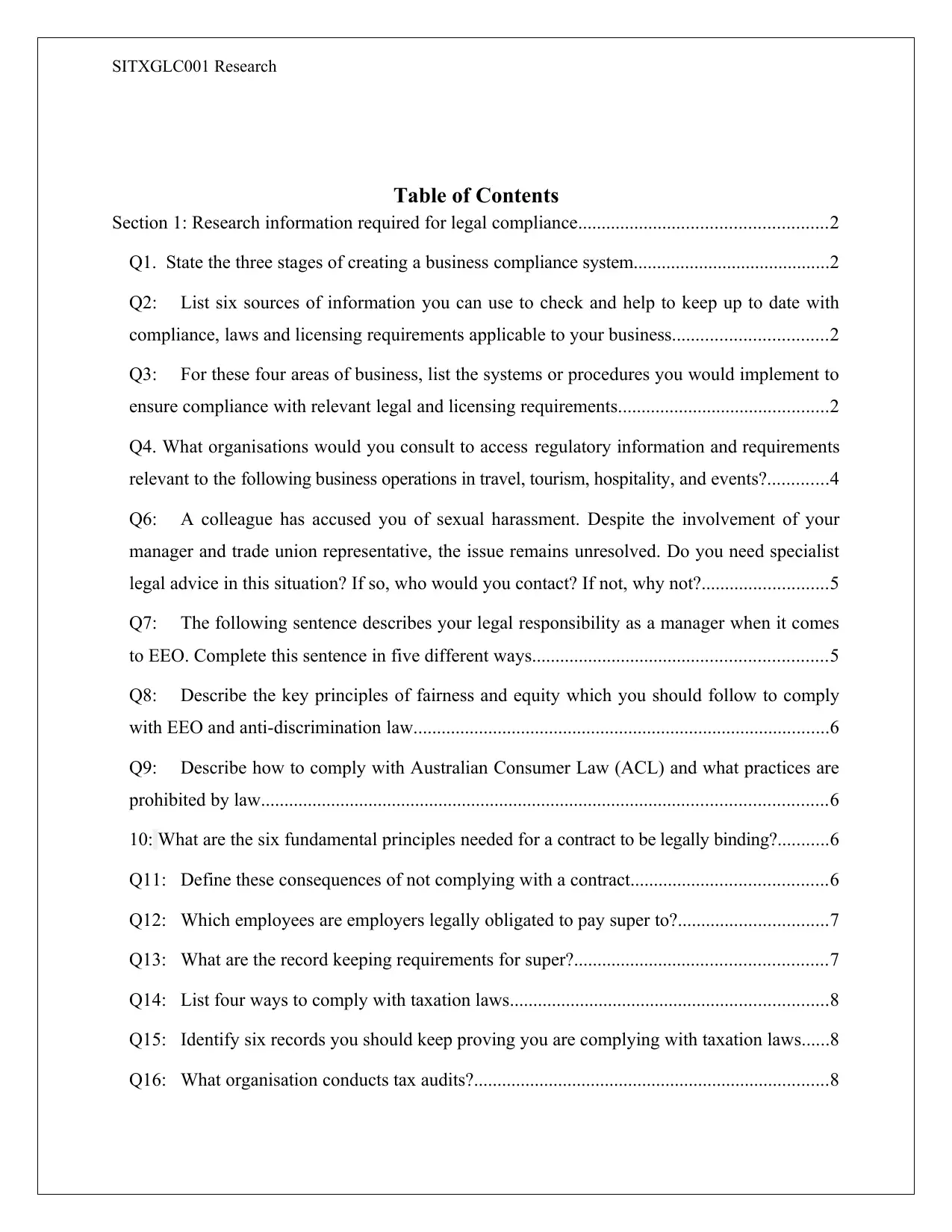
SITXGLC001 Research
Table of Contents
Section 1: Research information required for legal compliance.....................................................2
Q1. State the three stages of creating a business compliance system..........................................2
Q2: List six sources of information you can use to check and help to keep up to date with
compliance, laws and licensing requirements applicable to your business.................................2
Q3: For these four areas of business, list the systems or procedures you would implement to
ensure compliance with relevant legal and licensing requirements.............................................2
Q4. What organisations would you consult to access regulatory information and requirements
relevant to the following business operations in travel, tourism, hospitality, and events?.............4
Q6: A colleague has accused you of sexual harassment. Despite the involvement of your
manager and trade union representative, the issue remains unresolved. Do you need specialist
legal advice in this situation? If so, who would you contact? If not, why not?...........................5
Q7: The following sentence describes your legal responsibility as a manager when it comes
to EEO. Complete this sentence in five different ways...............................................................5
Q8: Describe the key principles of fairness and equity which you should follow to comply
with EEO and anti-discrimination law.........................................................................................6
Q9: Describe how to comply with Australian Consumer Law (ACL) and what practices are
prohibited by law.........................................................................................................................6
10: What are the six fundamental principles needed for a contract to be legally binding?...........6
Q11: Define these consequences of not complying with a contract..........................................6
Q12: Which employees are employers legally obligated to pay super to?................................7
Q13: What are the record keeping requirements for super?......................................................7
Q14: List four ways to comply with taxation laws....................................................................8
Q15: Identify six records you should keep proving you are complying with taxation laws......8
Q16: What organisation conducts tax audits?............................................................................8
Table of Contents
Section 1: Research information required for legal compliance.....................................................2
Q1. State the three stages of creating a business compliance system..........................................2
Q2: List six sources of information you can use to check and help to keep up to date with
compliance, laws and licensing requirements applicable to your business.................................2
Q3: For these four areas of business, list the systems or procedures you would implement to
ensure compliance with relevant legal and licensing requirements.............................................2
Q4. What organisations would you consult to access regulatory information and requirements
relevant to the following business operations in travel, tourism, hospitality, and events?.............4
Q6: A colleague has accused you of sexual harassment. Despite the involvement of your
manager and trade union representative, the issue remains unresolved. Do you need specialist
legal advice in this situation? If so, who would you contact? If not, why not?...........................5
Q7: The following sentence describes your legal responsibility as a manager when it comes
to EEO. Complete this sentence in five different ways...............................................................5
Q8: Describe the key principles of fairness and equity which you should follow to comply
with EEO and anti-discrimination law.........................................................................................6
Q9: Describe how to comply with Australian Consumer Law (ACL) and what practices are
prohibited by law.........................................................................................................................6
10: What are the six fundamental principles needed for a contract to be legally binding?...........6
Q11: Define these consequences of not complying with a contract..........................................6
Q12: Which employees are employers legally obligated to pay super to?................................7
Q13: What are the record keeping requirements for super?......................................................7
Q14: List four ways to comply with taxation laws....................................................................8
Q15: Identify six records you should keep proving you are complying with taxation laws......8
Q16: What organisation conducts tax audits?............................................................................8
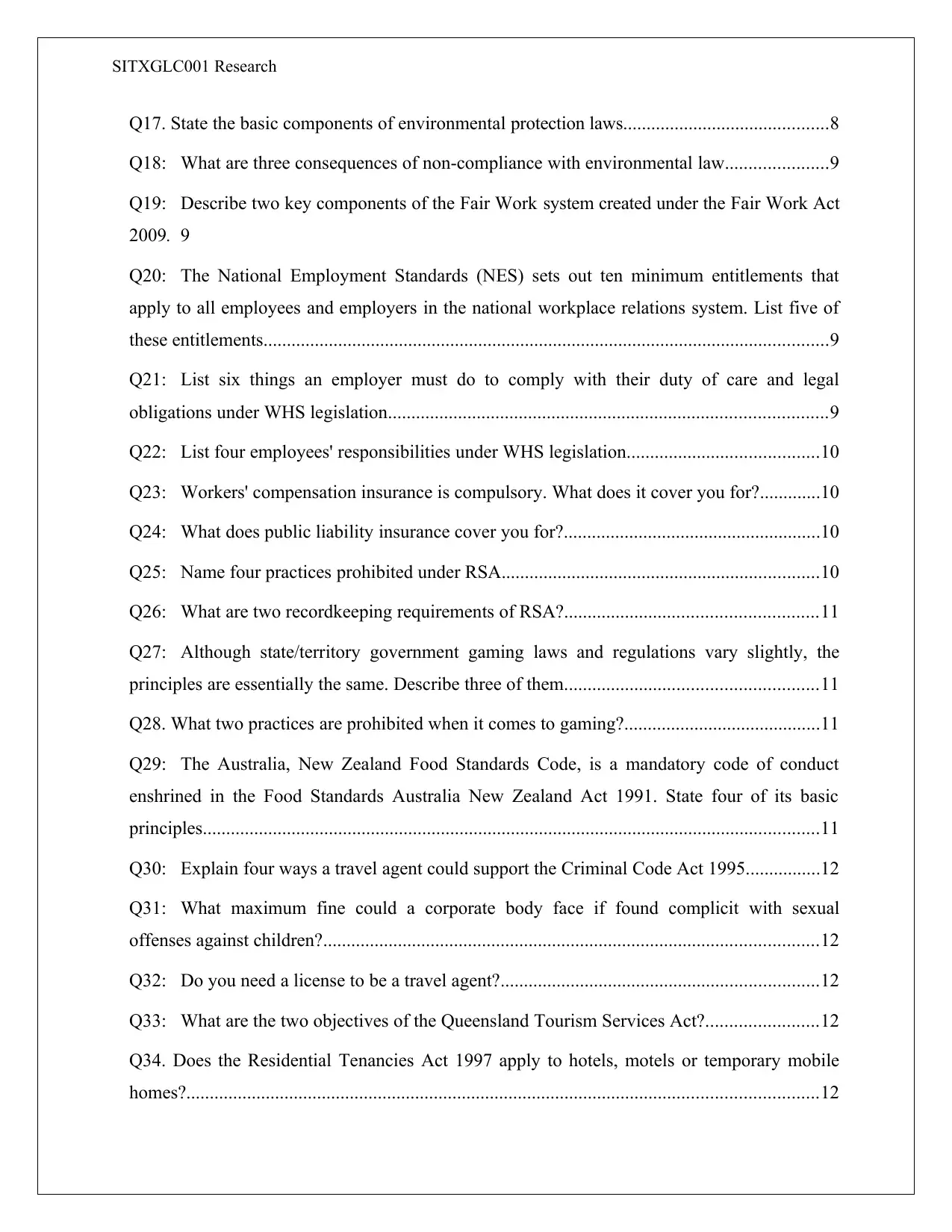
SITXGLC001 Research
Q17. State the basic components of environmental protection laws............................................8
Q18: What are three consequences of non-compliance with environmental law......................9
Q19: Describe two key components of the Fair Work system created under the Fair Work Act
2009. 9
Q20: The National Employment Standards (NES) sets out ten minimum entitlements that
apply to all employees and employers in the national workplace relations system. List five of
these entitlements.........................................................................................................................9
Q21: List six things an employer must do to comply with their duty of care and legal
obligations under WHS legislation..............................................................................................9
Q22: List four employees' responsibilities under WHS legislation.........................................10
Q23: Workers' compensation insurance is compulsory. What does it cover you for?.............10
Q24: What does public liability insurance cover you for?.......................................................10
Q25: Name four practices prohibited under RSA....................................................................10
Q26: What are two recordkeeping requirements of RSA?......................................................11
Q27: Although state/territory government gaming laws and regulations vary slightly, the
principles are essentially the same. Describe three of them......................................................11
Q28. What two practices are prohibited when it comes to gaming?..........................................11
Q29: The Australia, New Zealand Food Standards Code, is a mandatory code of conduct
enshrined in the Food Standards Australia New Zealand Act 1991. State four of its basic
principles....................................................................................................................................11
Q30: Explain four ways a travel agent could support the Criminal Code Act 1995................12
Q31: What maximum fine could a corporate body face if found complicit with sexual
offenses against children?..........................................................................................................12
Q32: Do you need a license to be a travel agent?....................................................................12
Q33: What are the two objectives of the Queensland Tourism Services Act?........................12
Q34. Does the Residential Tenancies Act 1997 apply to hotels, motels or temporary mobile
homes?.......................................................................................................................................12
Q17. State the basic components of environmental protection laws............................................8
Q18: What are three consequences of non-compliance with environmental law......................9
Q19: Describe two key components of the Fair Work system created under the Fair Work Act
2009. 9
Q20: The National Employment Standards (NES) sets out ten minimum entitlements that
apply to all employees and employers in the national workplace relations system. List five of
these entitlements.........................................................................................................................9
Q21: List six things an employer must do to comply with their duty of care and legal
obligations under WHS legislation..............................................................................................9
Q22: List four employees' responsibilities under WHS legislation.........................................10
Q23: Workers' compensation insurance is compulsory. What does it cover you for?.............10
Q24: What does public liability insurance cover you for?.......................................................10
Q25: Name four practices prohibited under RSA....................................................................10
Q26: What are two recordkeeping requirements of RSA?......................................................11
Q27: Although state/territory government gaming laws and regulations vary slightly, the
principles are essentially the same. Describe three of them......................................................11
Q28. What two practices are prohibited when it comes to gaming?..........................................11
Q29: The Australia, New Zealand Food Standards Code, is a mandatory code of conduct
enshrined in the Food Standards Australia New Zealand Act 1991. State four of its basic
principles....................................................................................................................................11
Q30: Explain four ways a travel agent could support the Criminal Code Act 1995................12
Q31: What maximum fine could a corporate body face if found complicit with sexual
offenses against children?..........................................................................................................12
Q32: Do you need a license to be a travel agent?....................................................................12
Q33: What are the two objectives of the Queensland Tourism Services Act?........................12
Q34. Does the Residential Tenancies Act 1997 apply to hotels, motels or temporary mobile
homes?.......................................................................................................................................12

SITXGLC001 Research
Q35. List two minimum standards the European Package Traveled Directive lays out to protect
customers?..................................................................................................................................13
Section 2- Develop and communicate policies and procedures for legal requirements................13
Q37: Policies are an important part of managing regulatory compliance. Describe the
components of a well-written compliance policy......................................................................13
Written policies and procedures that compose:.........................................................................13
Q38: You re opening a travel agency. List five policies and procedures you would need to
develop to comply with the law.................................................................................................14
Q39: Name two places you can keep policies and procedures, so they are accessible to all staff.
....................................................................................................................................................15
Q40: Identify two documents in which you should nominate the roles and responsibilities of
personnel for regulatory compliance..........................................................................................15
Q41: Who should you distribute policies, procedures and legal information to?......................15
Q42: Describe six ways you could distribute, communicate and share policies, procedures,
legal information, and updates in an organized way, so staff knows their roles and
responsibilities regarding compliance........................................................................................15
Section 3: Ensure compliance with legal requirements.................................................................16
Q43: Youre planning to open a new restaurant. List six regulatory authorities you might
communicate with first...............................................................................................................16
Q. 44: A staff member is about to have a meeting with a representative of the WHS authority
to determine the scope of compliance requirements for the new restaurant..............................16
Q45: List four ways to monitor and continually evaluate your business compliance system.. .17
Q46: What are the three components of risk management?......................................................17
Q47: What is a risk assessment used to measure?.....................................................................17
Q48: Read the following two scenarios. Describe any potential breaches of legislation you
identify.......................................................................................................................................18
Q35. List two minimum standards the European Package Traveled Directive lays out to protect
customers?..................................................................................................................................13
Section 2- Develop and communicate policies and procedures for legal requirements................13
Q37: Policies are an important part of managing regulatory compliance. Describe the
components of a well-written compliance policy......................................................................13
Written policies and procedures that compose:.........................................................................13
Q38: You re opening a travel agency. List five policies and procedures you would need to
develop to comply with the law.................................................................................................14
Q39: Name two places you can keep policies and procedures, so they are accessible to all staff.
....................................................................................................................................................15
Q40: Identify two documents in which you should nominate the roles and responsibilities of
personnel for regulatory compliance..........................................................................................15
Q41: Who should you distribute policies, procedures and legal information to?......................15
Q42: Describe six ways you could distribute, communicate and share policies, procedures,
legal information, and updates in an organized way, so staff knows their roles and
responsibilities regarding compliance........................................................................................15
Section 3: Ensure compliance with legal requirements.................................................................16
Q43: Youre planning to open a new restaurant. List six regulatory authorities you might
communicate with first...............................................................................................................16
Q. 44: A staff member is about to have a meeting with a representative of the WHS authority
to determine the scope of compliance requirements for the new restaurant..............................16
Q45: List four ways to monitor and continually evaluate your business compliance system.. .17
Q46: What are the three components of risk management?......................................................17
Q47: What is a risk assessment used to measure?.....................................................................17
Q48: Read the following two scenarios. Describe any potential breaches of legislation you
identify.......................................................................................................................................18
Secure Best Marks with AI Grader
Need help grading? Try our AI Grader for instant feedback on your assignments.
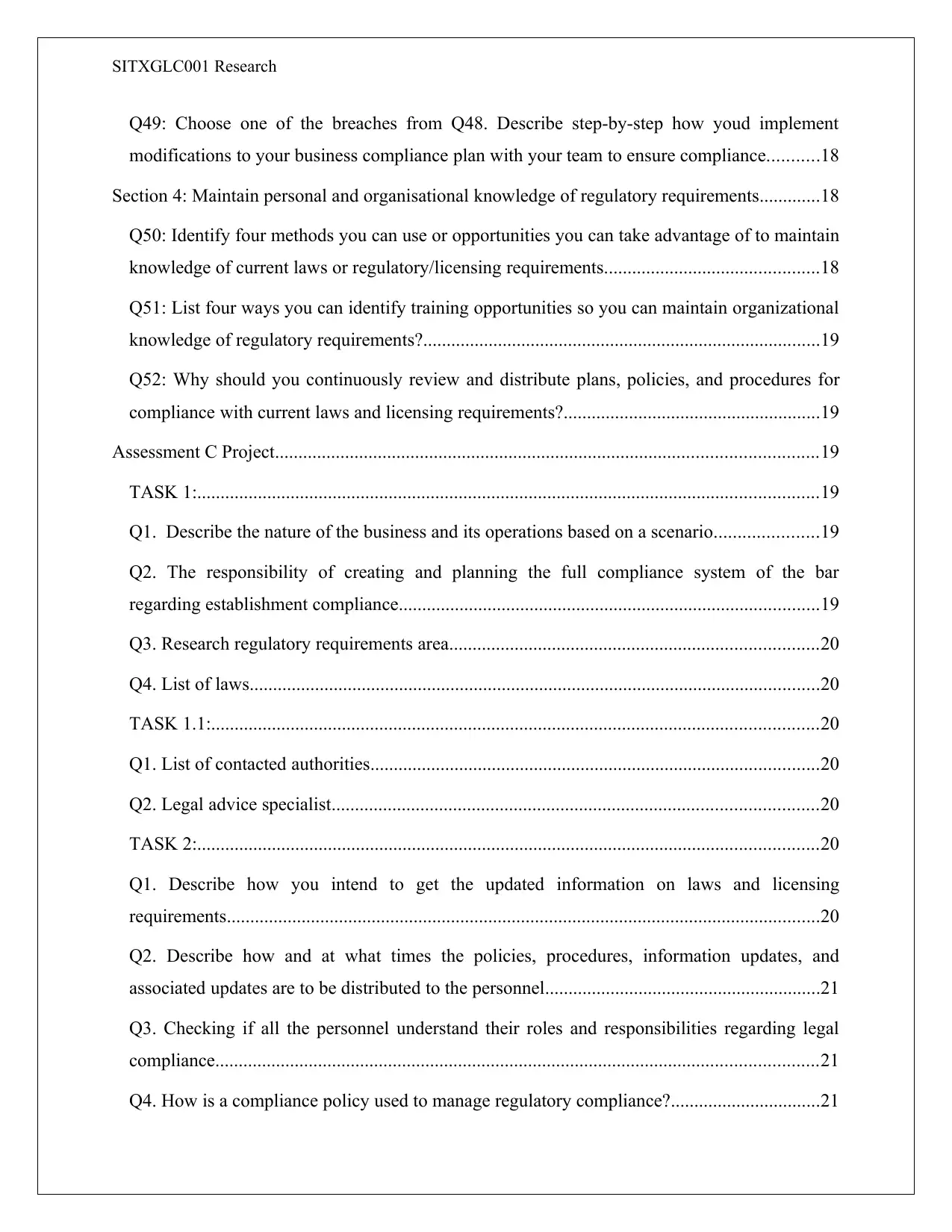
SITXGLC001 Research
Q49: Choose one of the breaches from Q48. Describe step-by-step how youd implement
modifications to your business compliance plan with your team to ensure compliance...........18
Section 4: Maintain personal and organisational knowledge of regulatory requirements.............18
Q50: Identify four methods you can use or opportunities you can take advantage of to maintain
knowledge of current laws or regulatory/licensing requirements..............................................18
Q51: List four ways you can identify training opportunities so you can maintain organizational
knowledge of regulatory requirements?.....................................................................................19
Q52: Why should you continuously review and distribute plans, policies, and procedures for
compliance with current laws and licensing requirements?.......................................................19
Assessment C Project....................................................................................................................19
TASK 1:.....................................................................................................................................19
Q1. Describe the nature of the business and its operations based on a scenario......................19
Q2. The responsibility of creating and planning the full compliance system of the bar
regarding establishment compliance..........................................................................................19
Q3. Research regulatory requirements area...............................................................................20
Q4. List of laws..........................................................................................................................20
TASK 1.1:..................................................................................................................................20
Q1. List of contacted authorities................................................................................................20
Q2. Legal advice specialist........................................................................................................20
TASK 2:.....................................................................................................................................20
Q1. Describe how you intend to get the updated information on laws and licensing
requirements...............................................................................................................................20
Q2. Describe how and at what times the policies, procedures, information updates, and
associated updates are to be distributed to the personnel...........................................................21
Q3. Checking if all the personnel understand their roles and responsibilities regarding legal
compliance.................................................................................................................................21
Q4. How is a compliance policy used to manage regulatory compliance?................................21
Q49: Choose one of the breaches from Q48. Describe step-by-step how youd implement
modifications to your business compliance plan with your team to ensure compliance...........18
Section 4: Maintain personal and organisational knowledge of regulatory requirements.............18
Q50: Identify four methods you can use or opportunities you can take advantage of to maintain
knowledge of current laws or regulatory/licensing requirements..............................................18
Q51: List four ways you can identify training opportunities so you can maintain organizational
knowledge of regulatory requirements?.....................................................................................19
Q52: Why should you continuously review and distribute plans, policies, and procedures for
compliance with current laws and licensing requirements?.......................................................19
Assessment C Project....................................................................................................................19
TASK 1:.....................................................................................................................................19
Q1. Describe the nature of the business and its operations based on a scenario......................19
Q2. The responsibility of creating and planning the full compliance system of the bar
regarding establishment compliance..........................................................................................19
Q3. Research regulatory requirements area...............................................................................20
Q4. List of laws..........................................................................................................................20
TASK 1.1:..................................................................................................................................20
Q1. List of contacted authorities................................................................................................20
Q2. Legal advice specialist........................................................................................................20
TASK 2:.....................................................................................................................................20
Q1. Describe how you intend to get the updated information on laws and licensing
requirements...............................................................................................................................20
Q2. Describe how and at what times the policies, procedures, information updates, and
associated updates are to be distributed to the personnel...........................................................21
Q3. Checking if all the personnel understand their roles and responsibilities regarding legal
compliance.................................................................................................................................21
Q4. How is a compliance policy used to manage regulatory compliance?................................21
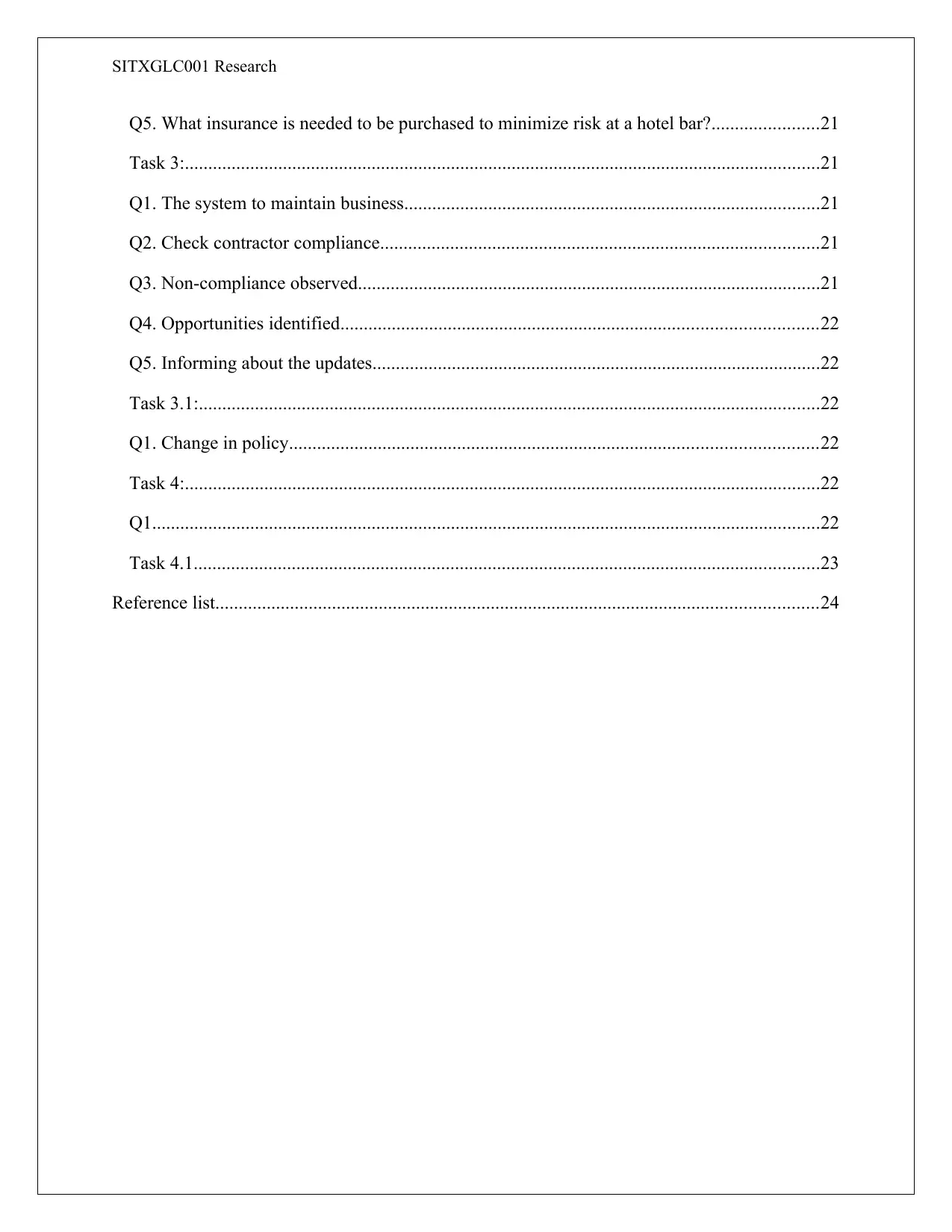
SITXGLC001 Research
Q5. What insurance is needed to be purchased to minimize risk at a hotel bar?.......................21
Task 3:........................................................................................................................................21
Q1. The system to maintain business.........................................................................................21
Q2. Check contractor compliance..............................................................................................21
Q3. Non-compliance observed...................................................................................................21
Q4. Opportunities identified......................................................................................................22
Q5. Informing about the updates................................................................................................22
Task 3.1:.....................................................................................................................................22
Q1. Change in policy.................................................................................................................22
Task 4:........................................................................................................................................22
Q1...............................................................................................................................................22
Task 4.1......................................................................................................................................23
Reference list.................................................................................................................................24
Q5. What insurance is needed to be purchased to minimize risk at a hotel bar?.......................21
Task 3:........................................................................................................................................21
Q1. The system to maintain business.........................................................................................21
Q2. Check contractor compliance..............................................................................................21
Q3. Non-compliance observed...................................................................................................21
Q4. Opportunities identified......................................................................................................22
Q5. Informing about the updates................................................................................................22
Task 3.1:.....................................................................................................................................22
Q1. Change in policy.................................................................................................................22
Task 4:........................................................................................................................................22
Q1...............................................................................................................................................22
Task 4.1......................................................................................................................................23
Reference list.................................................................................................................................24
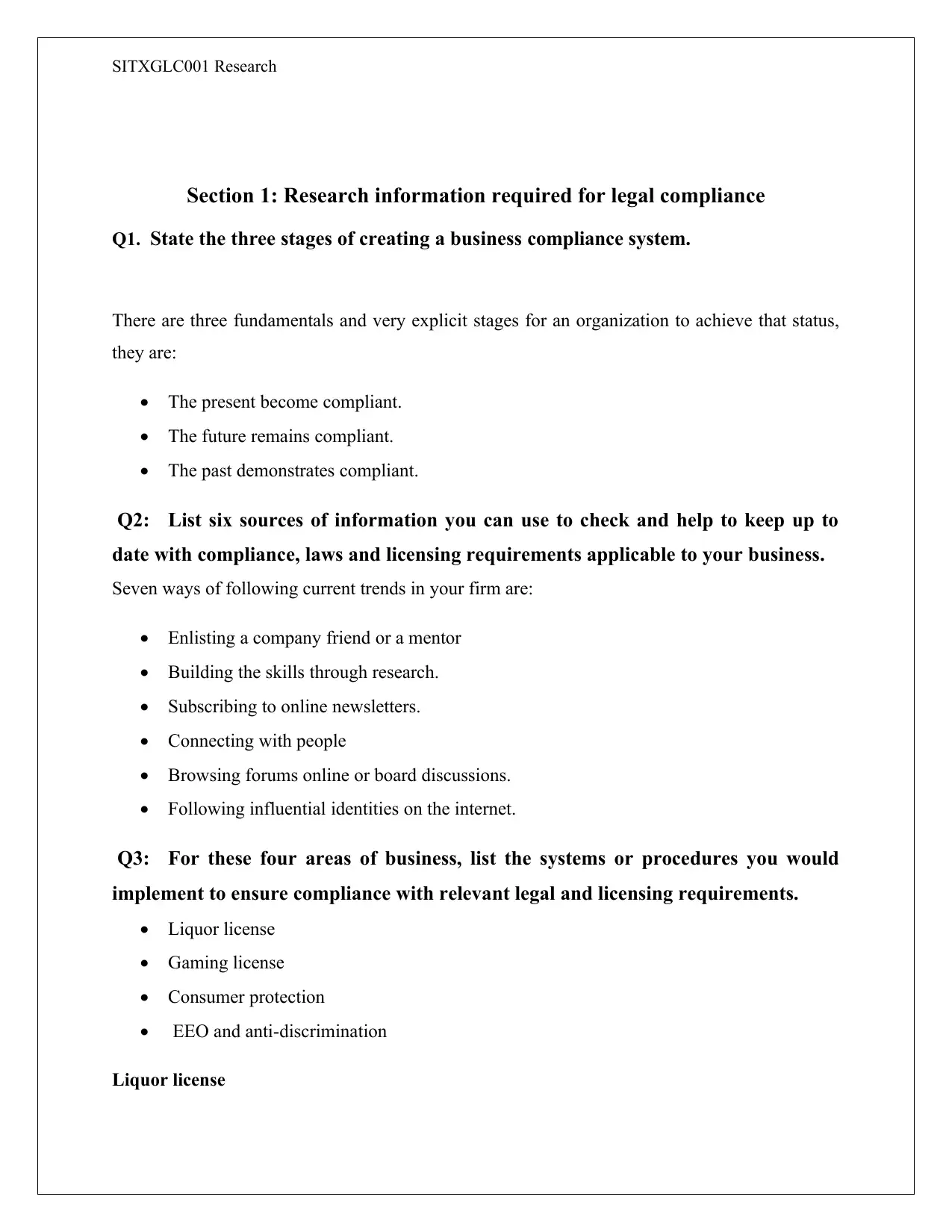
SITXGLC001 Research
Section 1: Research information required for legal compliance
Q1. State the three stages of creating a business compliance system.
There are three fundamentals and very explicit stages for an organization to achieve that status,
they are:
The present become compliant.
The future remains compliant.
The past demonstrates compliant.
Q2: List six sources of information you can use to check and help to keep up to
date with compliance, laws and licensing requirements applicable to your business.
Seven ways of following current trends in your firm are:
Enlisting a company friend or a mentor
Building the skills through research.
Subscribing to online newsletters.
Connecting with people
Browsing forums online or board discussions.
Following influential identities on the internet.
Q3: For these four areas of business, list the systems or procedures you would
implement to ensure compliance with relevant legal and licensing requirements.
Liquor license
Gaming license
Consumer protection
EEO and anti-discrimination
Liquor license
Section 1: Research information required for legal compliance
Q1. State the three stages of creating a business compliance system.
There are three fundamentals and very explicit stages for an organization to achieve that status,
they are:
The present become compliant.
The future remains compliant.
The past demonstrates compliant.
Q2: List six sources of information you can use to check and help to keep up to
date with compliance, laws and licensing requirements applicable to your business.
Seven ways of following current trends in your firm are:
Enlisting a company friend or a mentor
Building the skills through research.
Subscribing to online newsletters.
Connecting with people
Browsing forums online or board discussions.
Following influential identities on the internet.
Q3: For these four areas of business, list the systems or procedures you would
implement to ensure compliance with relevant legal and licensing requirements.
Liquor license
Gaming license
Consumer protection
EEO and anti-discrimination
Liquor license
Paraphrase This Document
Need a fresh take? Get an instant paraphrase of this document with our AI Paraphraser
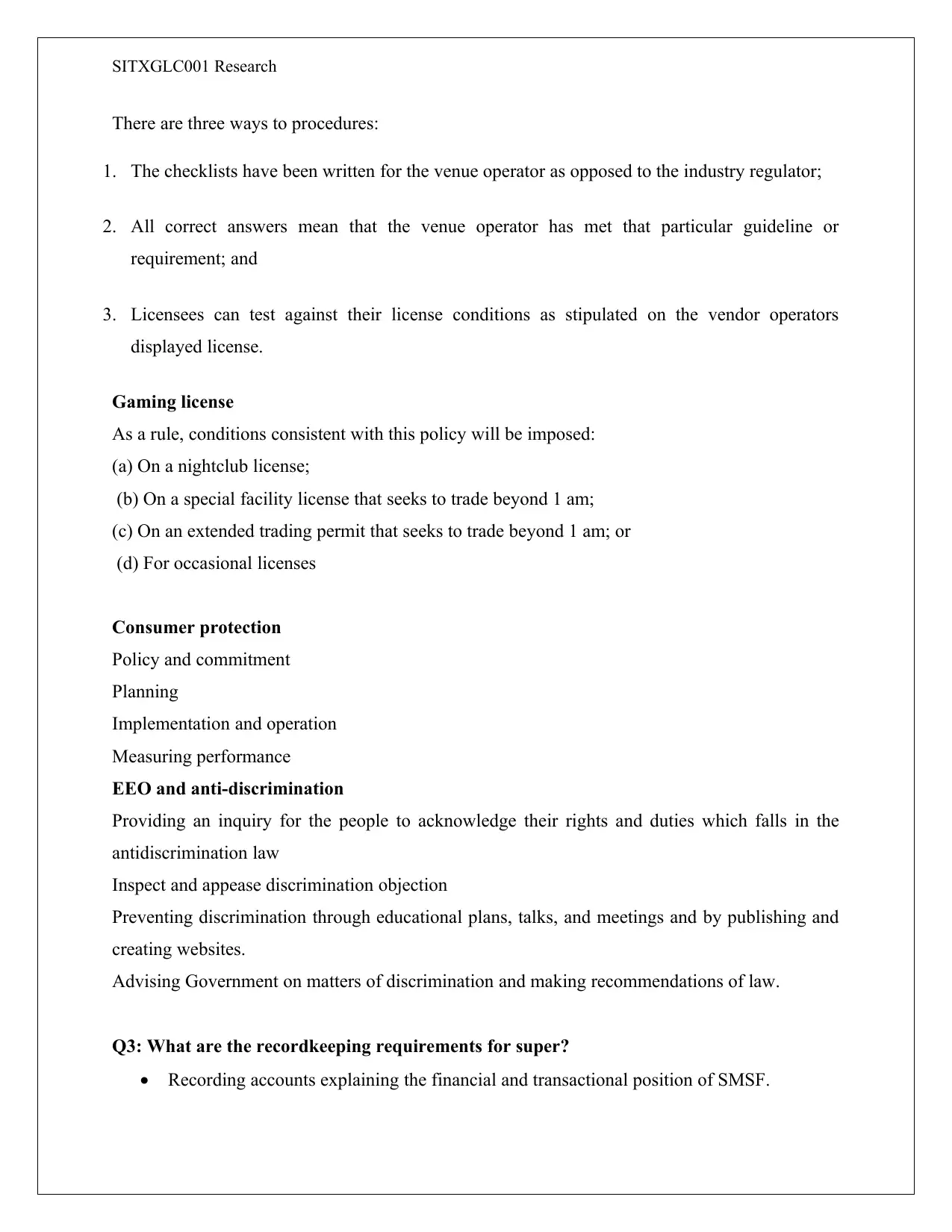
SITXGLC001 Research
There are three ways to procedures:
1. The checklists have been written for the venue operator as opposed to the industry regulator;
2. All correct answers mean that the venue operator has met that particular guideline or
requirement; and
3. Licensees can test against their license conditions as stipulated on the vendor operators
displayed license.
Gaming license
As a rule, conditions consistent with this policy will be imposed:
(a) On a nightclub license;
(b) On a special facility license that seeks to trade beyond 1 am;
(c) On an extended trading permit that seeks to trade beyond 1 am; or
(d) For occasional licenses
Consumer protection
Policy and commitment
Planning
Implementation and operation
Measuring performance
EEO and anti-discrimination
Providing an inquiry for the people to acknowledge their rights and duties which falls in the
antidiscrimination law
Inspect and appease discrimination objection
Preventing discrimination through educational plans, talks, and meetings and by publishing and
creating websites.
Advising Government on matters of discrimination and making recommendations of law.
Q3: What are the recordkeeping requirements for super?
Recording accounts explaining the financial and transactional position of SMSF.
There are three ways to procedures:
1. The checklists have been written for the venue operator as opposed to the industry regulator;
2. All correct answers mean that the venue operator has met that particular guideline or
requirement; and
3. Licensees can test against their license conditions as stipulated on the vendor operators
displayed license.
Gaming license
As a rule, conditions consistent with this policy will be imposed:
(a) On a nightclub license;
(b) On a special facility license that seeks to trade beyond 1 am;
(c) On an extended trading permit that seeks to trade beyond 1 am; or
(d) For occasional licenses
Consumer protection
Policy and commitment
Planning
Implementation and operation
Measuring performance
EEO and anti-discrimination
Providing an inquiry for the people to acknowledge their rights and duties which falls in the
antidiscrimination law
Inspect and appease discrimination objection
Preventing discrimination through educational plans, talks, and meetings and by publishing and
creating websites.
Advising Government on matters of discrimination and making recommendations of law.
Q3: What are the recordkeeping requirements for super?
Recording accounts explaining the financial and transactional position of SMSF.
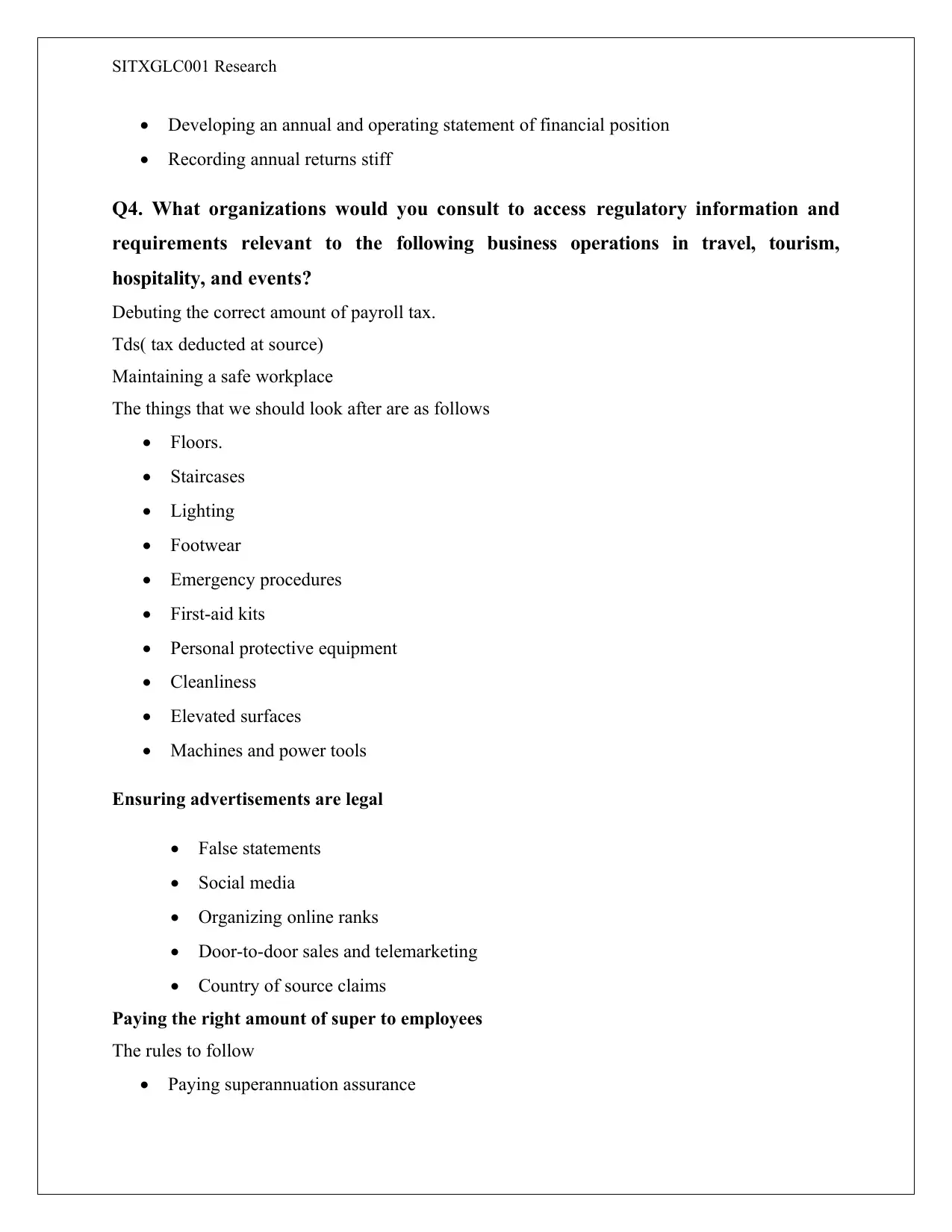
SITXGLC001 Research
Developing an annual and operating statement of financial position
Recording annual returns stiff
Q4. What organizations would you consult to access regulatory information and
requirements relevant to the following business operations in travel, tourism,
hospitality, and events?
Debuting the correct amount of payroll tax.
Tds( tax deducted at source)
Maintaining a safe workplace
The things that we should look after are as follows
Floors.
Staircases
Lighting
Footwear
Emergency procedures
First-aid kits
Personal protective equipment
Cleanliness
Elevated surfaces
Machines and power tools
Ensuring advertisements are legal
False statements
Social media
Organizing online ranks
Door-to-door sales and telemarketing
Country of source claims
Paying the right amount of super to employees
The rules to follow
Paying superannuation assurance
Developing an annual and operating statement of financial position
Recording annual returns stiff
Q4. What organizations would you consult to access regulatory information and
requirements relevant to the following business operations in travel, tourism,
hospitality, and events?
Debuting the correct amount of payroll tax.
Tds( tax deducted at source)
Maintaining a safe workplace
The things that we should look after are as follows
Floors.
Staircases
Lighting
Footwear
Emergency procedures
First-aid kits
Personal protective equipment
Cleanliness
Elevated surfaces
Machines and power tools
Ensuring advertisements are legal
False statements
Social media
Organizing online ranks
Door-to-door sales and telemarketing
Country of source claims
Paying the right amount of super to employees
The rules to follow
Paying superannuation assurance
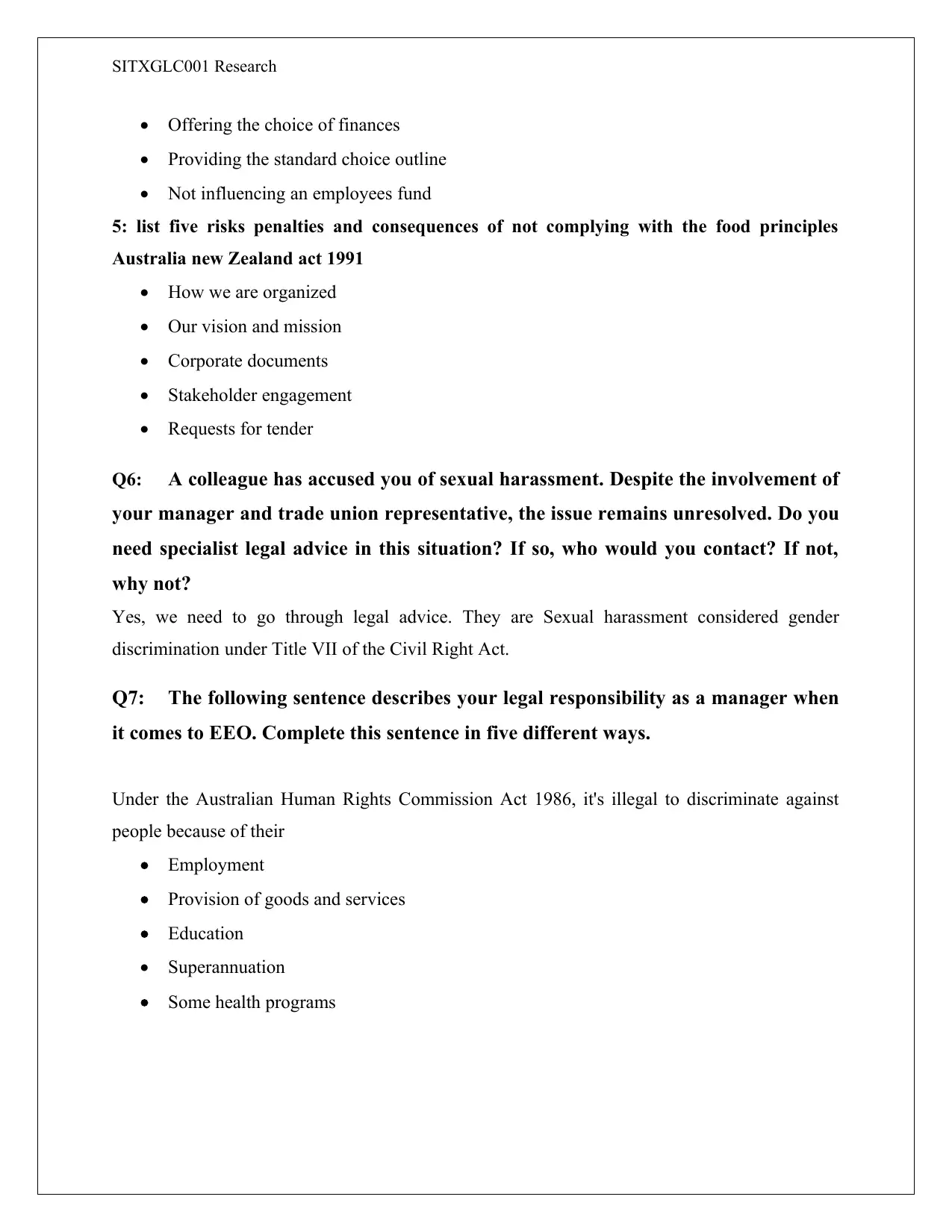
SITXGLC001 Research
Offering the choice of finances
Providing the standard choice outline
Not influencing an employees fund
5: list five risks penalties and consequences of not complying with the food principles
Australia new Zealand act 1991
How we are organized
Our vision and mission
Corporate documents
Stakeholder engagement
Requests for tender
Q6: A colleague has accused you of sexual harassment. Despite the involvement of
your manager and trade union representative, the issue remains unresolved. Do you
need specialist legal advice in this situation? If so, who would you contact? If not,
why not?
Yes, we need to go through legal advice. They are Sexual harassment considered gender
discrimination under Title VII of the Civil Right Act.
Q7: The following sentence describes your legal responsibility as a manager when
it comes to EEO. Complete this sentence in five different ways.
Under the Australian Human Rights Commission Act 1986, it's illegal to discriminate against
people because of their
Employment
Provision of goods and services
Education
Superannuation
Some health programs
Offering the choice of finances
Providing the standard choice outline
Not influencing an employees fund
5: list five risks penalties and consequences of not complying with the food principles
Australia new Zealand act 1991
How we are organized
Our vision and mission
Corporate documents
Stakeholder engagement
Requests for tender
Q6: A colleague has accused you of sexual harassment. Despite the involvement of
your manager and trade union representative, the issue remains unresolved. Do you
need specialist legal advice in this situation? If so, who would you contact? If not,
why not?
Yes, we need to go through legal advice. They are Sexual harassment considered gender
discrimination under Title VII of the Civil Right Act.
Q7: The following sentence describes your legal responsibility as a manager when
it comes to EEO. Complete this sentence in five different ways.
Under the Australian Human Rights Commission Act 1986, it's illegal to discriminate against
people because of their
Employment
Provision of goods and services
Education
Superannuation
Some health programs
Secure Best Marks with AI Grader
Need help grading? Try our AI Grader for instant feedback on your assignments.
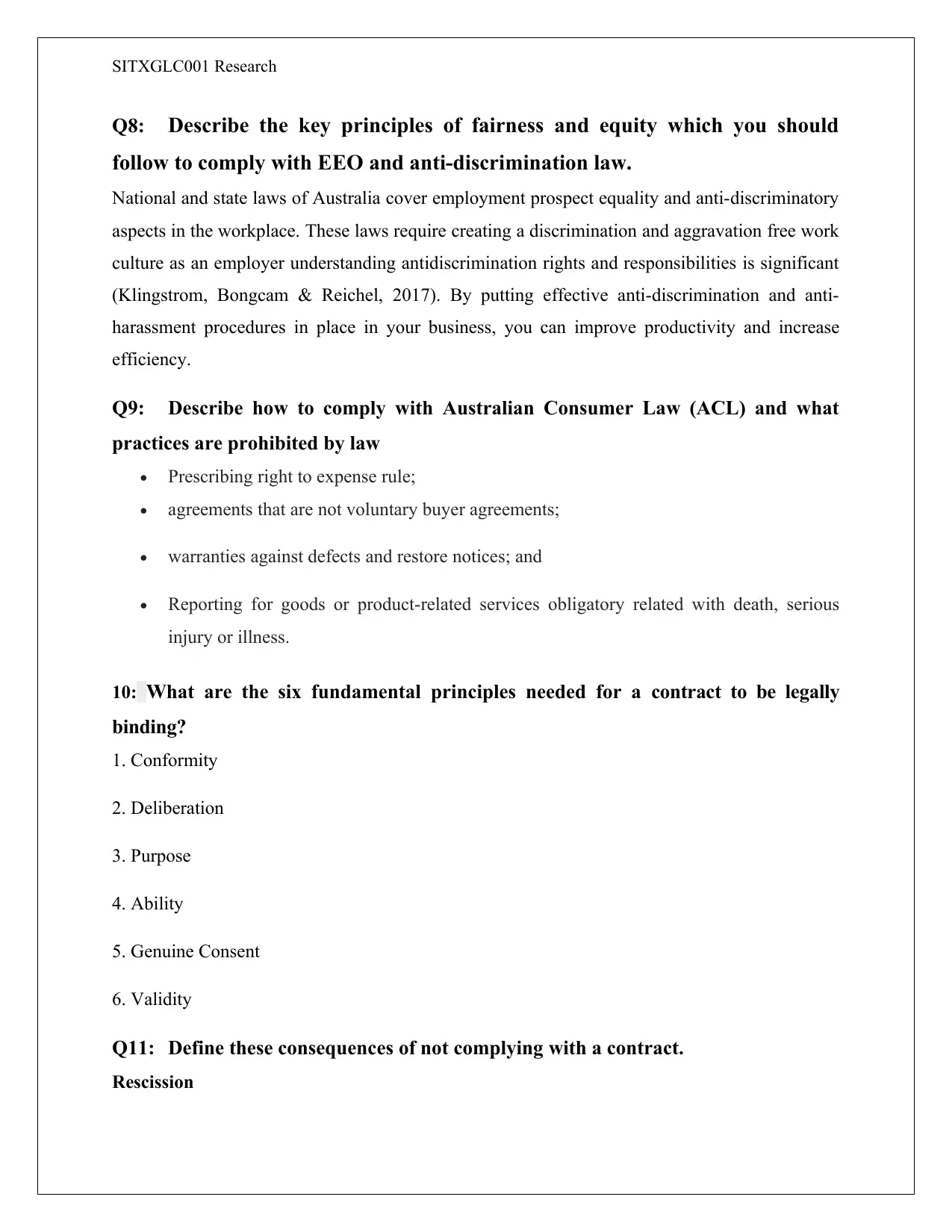
SITXGLC001 Research
Q8: Describe the key principles of fairness and equity which you should
follow to comply with EEO and anti-discrimination law.
National and state laws of Australia cover employment prospect equality and anti-discriminatory
aspects in the workplace. These laws require creating a discrimination and aggravation free work
culture as an employer understanding antidiscrimination rights and responsibilities is significant
(Klingstrom, Bongcam & Reichel, 2017). By putting effective anti-discrimination and anti-
harassment procedures in place in your business, you can improve productivity and increase
efficiency.
Q9: Describe how to comply with Australian Consumer Law (ACL) and what
practices are prohibited by law
Prescribing right to expense rule;
agreements that are not voluntary buyer agreements;
warranties against defects and restore notices; and
Reporting for goods or product-related services obligatory related with death, serious
injury or illness.
10: What are the six fundamental principles needed for a contract to be legally
binding?
1. Conformity
2. Deliberation
3. Purpose
4. Ability
5. Genuine Consent
6. Validity
Q11: Define these consequences of not complying with a contract.
Rescission
Q8: Describe the key principles of fairness and equity which you should
follow to comply with EEO and anti-discrimination law.
National and state laws of Australia cover employment prospect equality and anti-discriminatory
aspects in the workplace. These laws require creating a discrimination and aggravation free work
culture as an employer understanding antidiscrimination rights and responsibilities is significant
(Klingstrom, Bongcam & Reichel, 2017). By putting effective anti-discrimination and anti-
harassment procedures in place in your business, you can improve productivity and increase
efficiency.
Q9: Describe how to comply with Australian Consumer Law (ACL) and what
practices are prohibited by law
Prescribing right to expense rule;
agreements that are not voluntary buyer agreements;
warranties against defects and restore notices; and
Reporting for goods or product-related services obligatory related with death, serious
injury or illness.
10: What are the six fundamental principles needed for a contract to be legally
binding?
1. Conformity
2. Deliberation
3. Purpose
4. Ability
5. Genuine Consent
6. Validity
Q11: Define these consequences of not complying with a contract.
Rescission
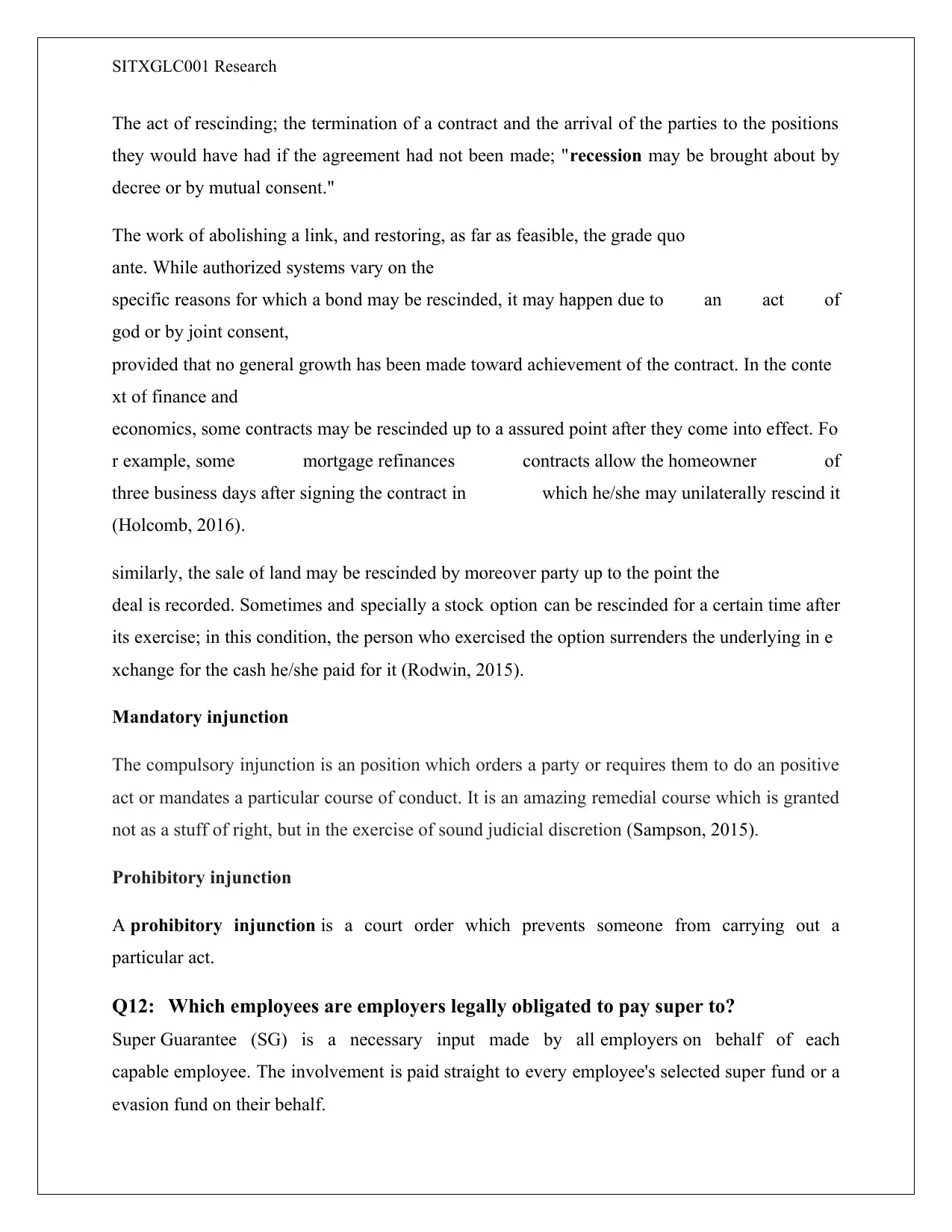
SITXGLC001 Research
The act of rescinding; the termination of a contract and the arrival of the parties to the positions
they would have had if the agreement had not been made; "recession may be brought about by
decree or by mutual consent."
The work of abolishing a link, and restoring, as far as feasible, the grade quo
ante. While authorized systems vary on the
specific reasons for which a bond may be rescinded, it may happen due to an act of
god or by joint consent,
provided that no general growth has been made toward achievement of the contract. In the conte
xt of finance and
economics, some contracts may be rescinded up to a assured point after they come into effect. Fo
r example, some mortgage refinances contracts allow the homeowner of
three business days after signing the contract in which he/she may unilaterally rescind it
(Holcomb, 2016).
similarly, the sale of land may be rescinded by moreover party up to the point the
deal is recorded. Sometimes and specially a stock option can be rescinded for a certain time after
its exercise; in this condition, the person who exercised the option surrenders the underlying in e
xchange for the cash he/she paid for it (Rodwin, 2015).
Mandatory injunction
The compulsory injunction is an position which orders a party or requires them to do an positive
act or mandates a particular course of conduct. It is an amazing remedial course which is granted
not as a stuff of right, but in the exercise of sound judicial discretion (Sampson, 2015).
Prohibitory injunction
A prohibitory injunction is a court order which prevents someone from carrying out a
particular act.
Q12: Which employees are employers legally obligated to pay super to?
Super Guarantee (SG) is a necessary input made by all employers on behalf of each
capable employee. The involvement is paid straight to every employee's selected super fund or a
evasion fund on their behalf.
The act of rescinding; the termination of a contract and the arrival of the parties to the positions
they would have had if the agreement had not been made; "recession may be brought about by
decree or by mutual consent."
The work of abolishing a link, and restoring, as far as feasible, the grade quo
ante. While authorized systems vary on the
specific reasons for which a bond may be rescinded, it may happen due to an act of
god or by joint consent,
provided that no general growth has been made toward achievement of the contract. In the conte
xt of finance and
economics, some contracts may be rescinded up to a assured point after they come into effect. Fo
r example, some mortgage refinances contracts allow the homeowner of
three business days after signing the contract in which he/she may unilaterally rescind it
(Holcomb, 2016).
similarly, the sale of land may be rescinded by moreover party up to the point the
deal is recorded. Sometimes and specially a stock option can be rescinded for a certain time after
its exercise; in this condition, the person who exercised the option surrenders the underlying in e
xchange for the cash he/she paid for it (Rodwin, 2015).
Mandatory injunction
The compulsory injunction is an position which orders a party or requires them to do an positive
act or mandates a particular course of conduct. It is an amazing remedial course which is granted
not as a stuff of right, but in the exercise of sound judicial discretion (Sampson, 2015).
Prohibitory injunction
A prohibitory injunction is a court order which prevents someone from carrying out a
particular act.
Q12: Which employees are employers legally obligated to pay super to?
Super Guarantee (SG) is a necessary input made by all employers on behalf of each
capable employee. The involvement is paid straight to every employee's selected super fund or a
evasion fund on their behalf.
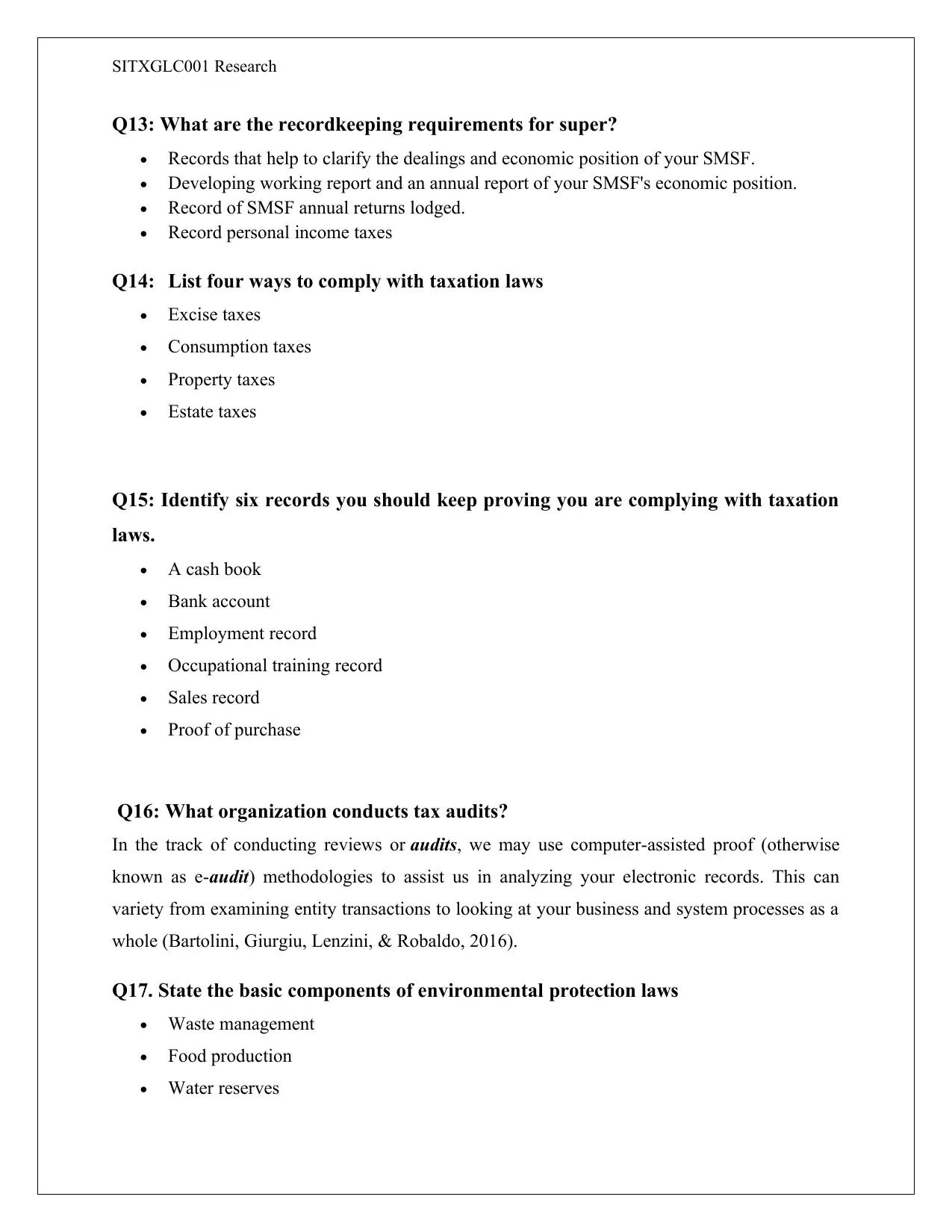
SITXGLC001 Research
Q13: What are the recordkeeping requirements for super?
Records that help to clarify the dealings and economic position of your SMSF.
Developing working report and an annual report of your SMSF's economic position.
Record of SMSF annual returns lodged.
Record personal income taxes
Q14: List four ways to comply with taxation laws
Excise taxes
Consumption taxes
Property taxes
Estate taxes
Q15: Identify six records you should keep proving you are complying with taxation
laws.
A cash book
Bank account
Employment record
Occupational training record
Sales record
Proof of purchase
Q16: What organization conducts tax audits?
In the track of conducting reviews or audits, we may use computer-assisted proof (otherwise
known as e-audit) methodologies to assist us in analyzing your electronic records. This can
variety from examining entity transactions to looking at your business and system processes as a
whole (Bartolini, Giurgiu, Lenzini, & Robaldo, 2016).
Q17. State the basic components of environmental protection laws
Waste management
Food production
Water reserves
Q13: What are the recordkeeping requirements for super?
Records that help to clarify the dealings and economic position of your SMSF.
Developing working report and an annual report of your SMSF's economic position.
Record of SMSF annual returns lodged.
Record personal income taxes
Q14: List four ways to comply with taxation laws
Excise taxes
Consumption taxes
Property taxes
Estate taxes
Q15: Identify six records you should keep proving you are complying with taxation
laws.
A cash book
Bank account
Employment record
Occupational training record
Sales record
Proof of purchase
Q16: What organization conducts tax audits?
In the track of conducting reviews or audits, we may use computer-assisted proof (otherwise
known as e-audit) methodologies to assist us in analyzing your electronic records. This can
variety from examining entity transactions to looking at your business and system processes as a
whole (Bartolini, Giurgiu, Lenzini, & Robaldo, 2016).
Q17. State the basic components of environmental protection laws
Waste management
Food production
Water reserves
Paraphrase This Document
Need a fresh take? Get an instant paraphrase of this document with our AI Paraphraser

SITXGLC001 Research
Population control and remediation
Mining
Q18: What are three consequences of non-compliance with the environmental law
Fines and imprisonment
Clean up notices
Civil sanctions
Q19: Describe two key components of the Fair Work system created under the Fair
Work Act 2009
.
Fundamental particles and forces
And matter-radiation from the universe
Q20: The National service Standards (NES) sets out ten least amount entitlements
that apply to all workers and employers in the national workplace associations
system. List five of these entitlements
Annual holiday
Private care and sympathetic leave.
Highest weekly hours
Requesting supple working provision
Parental depart and associated entitlements.
Q21: List six things an employer must do to comply with their duty of care and
legal obligations under WHS legislation
Keeping employee record
Managing recurring workers
Work wellbeing and protection
Population control and remediation
Mining
Q18: What are three consequences of non-compliance with the environmental law
Fines and imprisonment
Clean up notices
Civil sanctions
Q19: Describe two key components of the Fair Work system created under the Fair
Work Act 2009
.
Fundamental particles and forces
And matter-radiation from the universe
Q20: The National service Standards (NES) sets out ten least amount entitlements
that apply to all workers and employers in the national workplace associations
system. List five of these entitlements
Annual holiday
Private care and sympathetic leave.
Highest weekly hours
Requesting supple working provision
Parental depart and associated entitlements.
Q21: List six things an employer must do to comply with their duty of care and
legal obligations under WHS legislation
Keeping employee record
Managing recurring workers
Work wellbeing and protection

SITXGLC001 Research
Enforcing place of work polices
On-boarding and initiation
Contractors
Q22: List four employees' responsibilities under WHS legislation
WHS and volunteers
Unpaid graduates
Keeping up to date
Workplace health and safety hazards and accidents
Q23: Workers' compensation insurance is compulsory. What does it cover you for?
Workers compensation covers just my medical bills like hospital and medical fixed cost
required to diagnose and treat injury. However, it provides disability payments too while one is
unable to work (typically, about two-thirds of your regular salary).
Q24: What does public liability insurance cover you for?
Public liability-Public liability cover covers a person, a business, an event, a contractor even a
community building from legal action costs if originate liable for death or injury, loss or damage
of property, or profitable loss ensuing from their negligence.
Q25: Name four practices prohibited under RSA.
encourages irresponsible drinking (e.g. 'drinking the shelf,' ' the last man standing,' 'all
you can drink,' 'drink like a fish' or 'beat the clock')
discourages monitoring or scheming patron the total they drink (e.g., serving liquor in
yard glasses, test tubes without a stand, or jugs without glasses)
hammering or shooting alcoholic drinks directly into clients mouths (e.g. 'laybacks')
have a individual request to children (e.g., because of the use of designs, names, motifs or
characters that are likely to be attractive to children).
Enforcing place of work polices
On-boarding and initiation
Contractors
Q22: List four employees' responsibilities under WHS legislation
WHS and volunteers
Unpaid graduates
Keeping up to date
Workplace health and safety hazards and accidents
Q23: Workers' compensation insurance is compulsory. What does it cover you for?
Workers compensation covers just my medical bills like hospital and medical fixed cost
required to diagnose and treat injury. However, it provides disability payments too while one is
unable to work (typically, about two-thirds of your regular salary).
Q24: What does public liability insurance cover you for?
Public liability-Public liability cover covers a person, a business, an event, a contractor even a
community building from legal action costs if originate liable for death or injury, loss or damage
of property, or profitable loss ensuing from their negligence.
Q25: Name four practices prohibited under RSA.
encourages irresponsible drinking (e.g. 'drinking the shelf,' ' the last man standing,' 'all
you can drink,' 'drink like a fish' or 'beat the clock')
discourages monitoring or scheming patron the total they drink (e.g., serving liquor in
yard glasses, test tubes without a stand, or jugs without glasses)
hammering or shooting alcoholic drinks directly into clients mouths (e.g. 'laybacks')
have a individual request to children (e.g., because of the use of designs, names, motifs or
characters that are likely to be attractive to children).
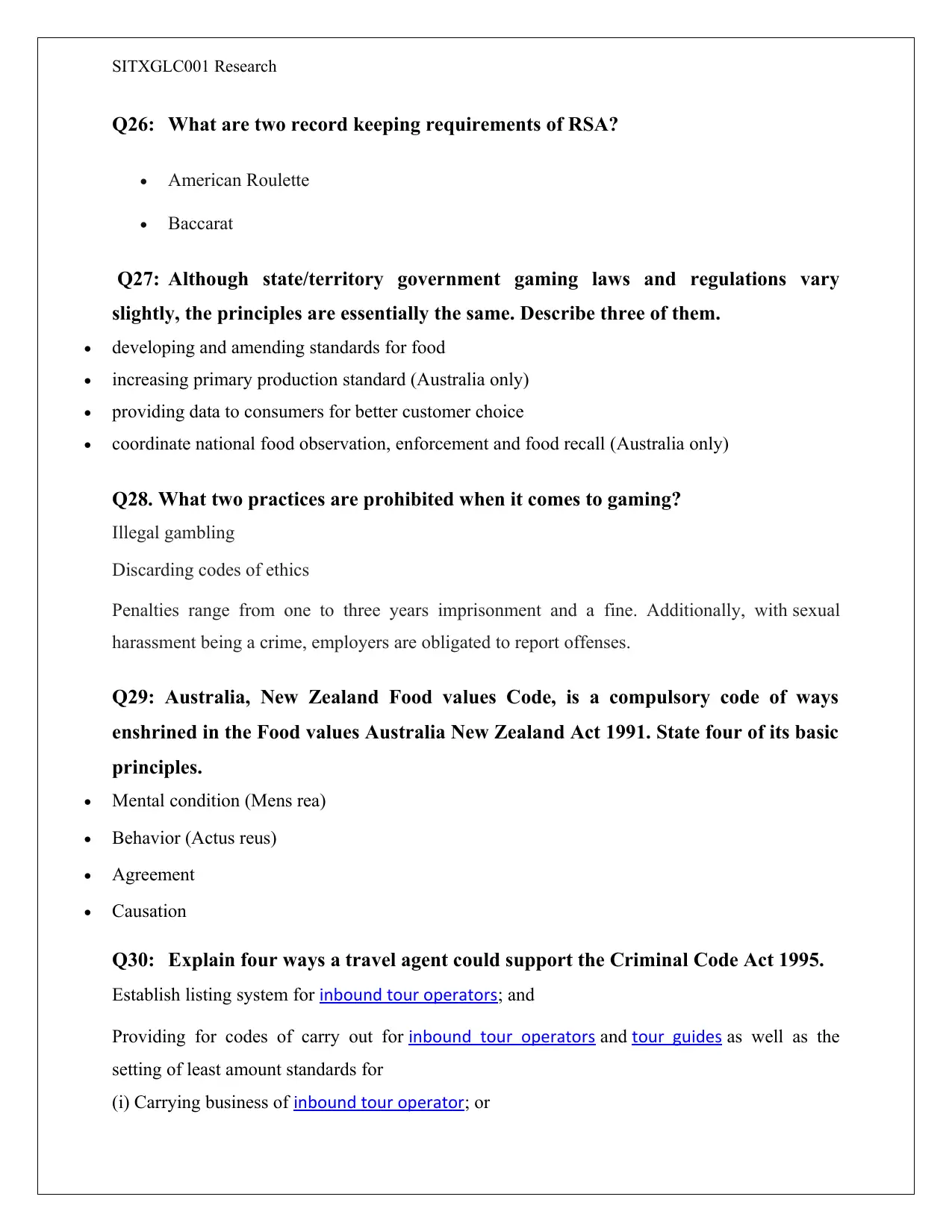
SITXGLC001 Research
Q26: What are two record keeping requirements of RSA?
American Roulette
Baccarat
Q27: Although state/territory government gaming laws and regulations vary
slightly, the principles are essentially the same. Describe three of them.
developing and amending standards for food
increasing primary production standard (Australia only)
providing data to consumers for better customer choice
coordinate national food observation, enforcement and food recall (Australia only)
Q28. What two practices are prohibited when it comes to gaming?
Illegal gambling
Discarding codes of ethics
Penalties range from one to three years imprisonment and a fine. Additionally, with sexual
harassment being a crime, employers are obligated to report offenses.
Q29: Australia, New Zealand Food values Code, is a compulsory code of ways
enshrined in the Food values Australia New Zealand Act 1991. State four of its basic
principles.
Mental condition (Mens rea)
Behavior (Actus reus)
Agreement
Causation
Q30: Explain four ways a travel agent could support the Criminal Code Act 1995.
Establish listing system for inbound tour operators; and
Providing for codes of carry out for inbound tour operators and tour guides as well as the
setting of least amount standards for
(i) Carrying business of inbound tour operator; or
Q26: What are two record keeping requirements of RSA?
American Roulette
Baccarat
Q27: Although state/territory government gaming laws and regulations vary
slightly, the principles are essentially the same. Describe three of them.
developing and amending standards for food
increasing primary production standard (Australia only)
providing data to consumers for better customer choice
coordinate national food observation, enforcement and food recall (Australia only)
Q28. What two practices are prohibited when it comes to gaming?
Illegal gambling
Discarding codes of ethics
Penalties range from one to three years imprisonment and a fine. Additionally, with sexual
harassment being a crime, employers are obligated to report offenses.
Q29: Australia, New Zealand Food values Code, is a compulsory code of ways
enshrined in the Food values Australia New Zealand Act 1991. State four of its basic
principles.
Mental condition (Mens rea)
Behavior (Actus reus)
Agreement
Causation
Q30: Explain four ways a travel agent could support the Criminal Code Act 1995.
Establish listing system for inbound tour operators; and
Providing for codes of carry out for inbound tour operators and tour guides as well as the
setting of least amount standards for
(i) Carrying business of inbound tour operator; or
Secure Best Marks with AI Grader
Need help grading? Try our AI Grader for instant feedback on your assignments.
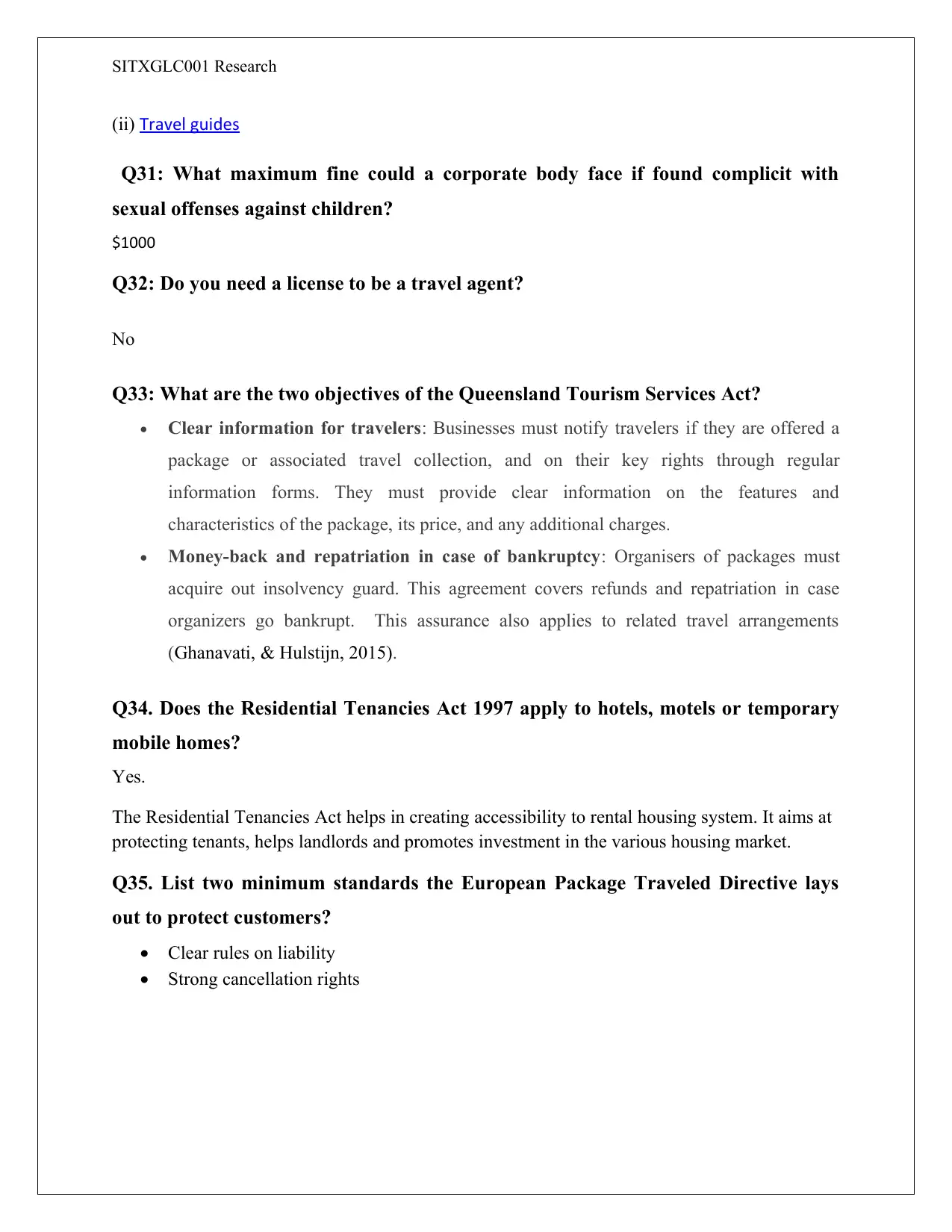
SITXGLC001 Research
(ii) Travel guides
Q31: What maximum fine could a corporate body face if found complicit with
sexual offenses against children?
$1000
Q32: Do you need a license to be a travel agent?
No
Q33: What are the two objectives of the Queensland Tourism Services Act?
Clear information for travelers: Businesses must notify travelers if they are offered a
package or associated travel collection, and on their key rights through regular
information forms. They must provide clear information on the features and
characteristics of the package, its price, and any additional charges.
Money-back and repatriation in case of bankruptcy: Organisers of packages must
acquire out insolvency guard. This agreement covers refunds and repatriation in case
organizers go bankrupt. This assurance also applies to related travel arrangements
(Ghanavati, & Hulstijn, 2015).
Q34. Does the Residential Tenancies Act 1997 apply to hotels, motels or temporary
mobile homes?
Yes.
The Residential Tenancies Act helps in creating accessibility to rental housing system. It aims at
protecting tenants, helps landlords and promotes investment in the various housing market.
Q35. List two minimum standards the European Package Traveled Directive lays
out to protect customers?
Clear rules on liability
Strong cancellation rights
(ii) Travel guides
Q31: What maximum fine could a corporate body face if found complicit with
sexual offenses against children?
$1000
Q32: Do you need a license to be a travel agent?
No
Q33: What are the two objectives of the Queensland Tourism Services Act?
Clear information for travelers: Businesses must notify travelers if they are offered a
package or associated travel collection, and on their key rights through regular
information forms. They must provide clear information on the features and
characteristics of the package, its price, and any additional charges.
Money-back and repatriation in case of bankruptcy: Organisers of packages must
acquire out insolvency guard. This agreement covers refunds and repatriation in case
organizers go bankrupt. This assurance also applies to related travel arrangements
(Ghanavati, & Hulstijn, 2015).
Q34. Does the Residential Tenancies Act 1997 apply to hotels, motels or temporary
mobile homes?
Yes.
The Residential Tenancies Act helps in creating accessibility to rental housing system. It aims at
protecting tenants, helps landlords and promotes investment in the various housing market.
Q35. List two minimum standards the European Package Traveled Directive lays
out to protect customers?
Clear rules on liability
Strong cancellation rights
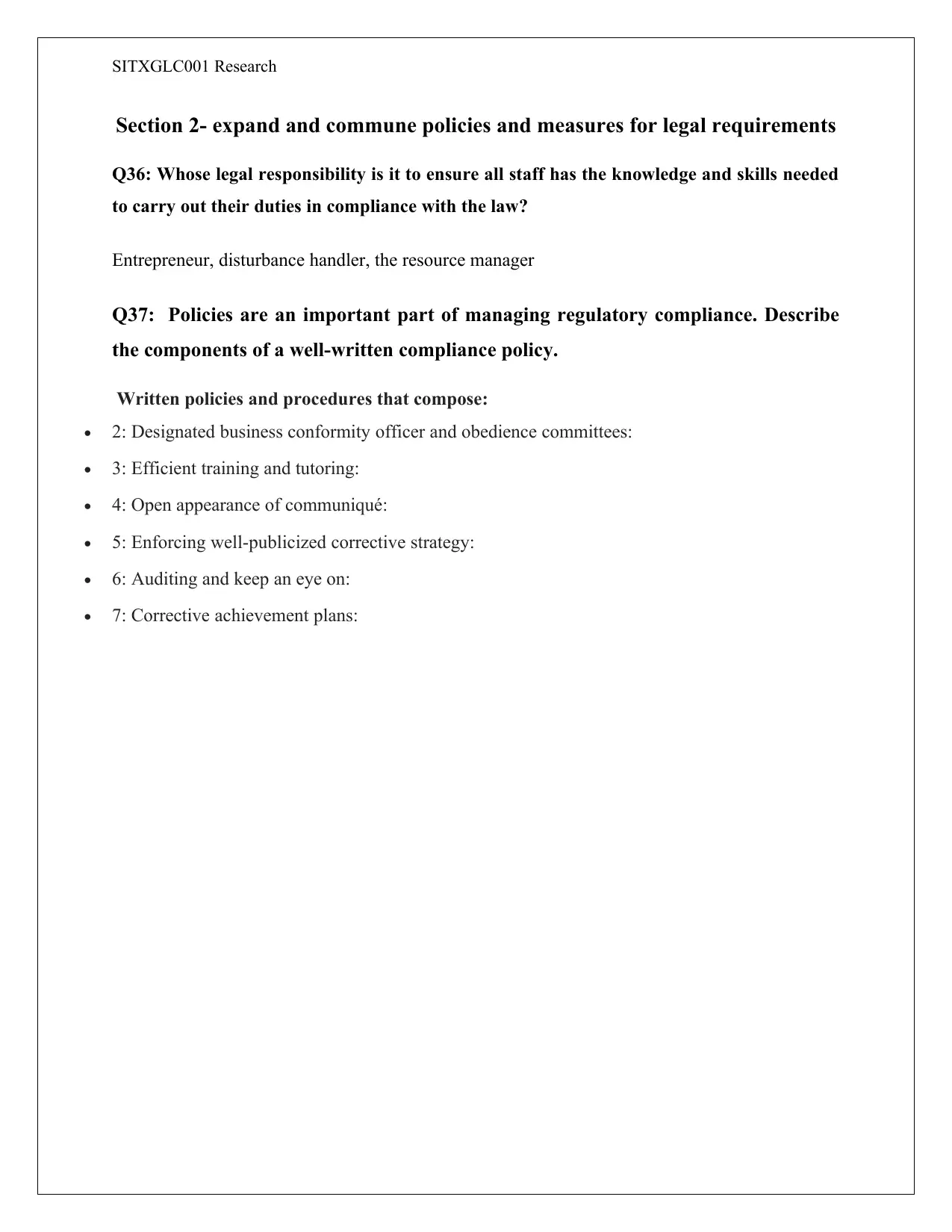
SITXGLC001 Research
Section 2- expand and commune policies and measures for legal requirements
Q36: Whose legal responsibility is it to ensure all staff has the knowledge and skills needed
to carry out their duties in compliance with the law?
Entrepreneur, disturbance handler, the resource manager
Q37: Policies are an important part of managing regulatory compliance. Describe
the components of a well-written compliance policy.
Written policies and procedures that compose:
2: Designated business conformity officer and obedience committees:
3: Efficient training and tutoring:
4: Open appearance of communiqué:
5: Enforcing well-publicized corrective strategy:
6: Auditing and keep an eye on:
7: Corrective achievement plans:
Section 2- expand and commune policies and measures for legal requirements
Q36: Whose legal responsibility is it to ensure all staff has the knowledge and skills needed
to carry out their duties in compliance with the law?
Entrepreneur, disturbance handler, the resource manager
Q37: Policies are an important part of managing regulatory compliance. Describe
the components of a well-written compliance policy.
Written policies and procedures that compose:
2: Designated business conformity officer and obedience committees:
3: Efficient training and tutoring:
4: Open appearance of communiqué:
5: Enforcing well-publicized corrective strategy:
6: Auditing and keep an eye on:
7: Corrective achievement plans:
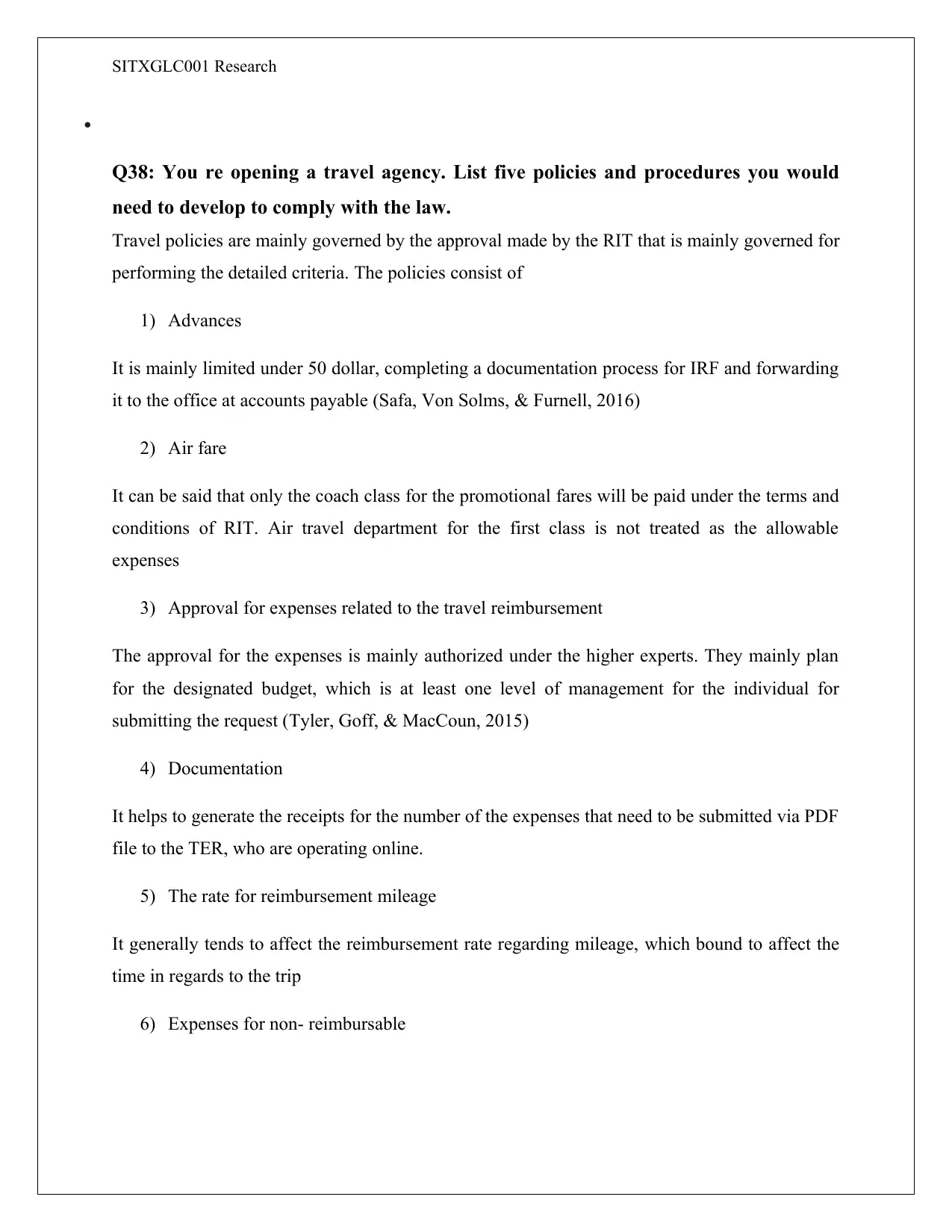
SITXGLC001 Research
Q38: You re opening a travel agency. List five policies and procedures you would
need to develop to comply with the law.
Travel policies are mainly governed by the approval made by the RIT that is mainly governed for
performing the detailed criteria. The policies consist of
1) Advances
It is mainly limited under 50 dollar, completing a documentation process for IRF and forwarding
it to the office at accounts payable (Safa, Von Solms, & Furnell, 2016)
2) Air fare
It can be said that only the coach class for the promotional fares will be paid under the terms and
conditions of RIT. Air travel department for the first class is not treated as the allowable
expenses
3) Approval for expenses related to the travel reimbursement
The approval for the expenses is mainly authorized under the higher experts. They mainly plan
for the designated budget, which is at least one level of management for the individual for
submitting the request (Tyler, Goff, & MacCoun, 2015)
4) Documentation
It helps to generate the receipts for the number of the expenses that need to be submitted via PDF
file to the TER, who are operating online.
5) The rate for reimbursement mileage
It generally tends to affect the reimbursement rate regarding mileage, which bound to affect the
time in regards to the trip
6) Expenses for non- reimbursable
Q38: You re opening a travel agency. List five policies and procedures you would
need to develop to comply with the law.
Travel policies are mainly governed by the approval made by the RIT that is mainly governed for
performing the detailed criteria. The policies consist of
1) Advances
It is mainly limited under 50 dollar, completing a documentation process for IRF and forwarding
it to the office at accounts payable (Safa, Von Solms, & Furnell, 2016)
2) Air fare
It can be said that only the coach class for the promotional fares will be paid under the terms and
conditions of RIT. Air travel department for the first class is not treated as the allowable
expenses
3) Approval for expenses related to the travel reimbursement
The approval for the expenses is mainly authorized under the higher experts. They mainly plan
for the designated budget, which is at least one level of management for the individual for
submitting the request (Tyler, Goff, & MacCoun, 2015)
4) Documentation
It helps to generate the receipts for the number of the expenses that need to be submitted via PDF
file to the TER, who are operating online.
5) The rate for reimbursement mileage
It generally tends to affect the reimbursement rate regarding mileage, which bound to affect the
time in regards to the trip
6) Expenses for non- reimbursable
Paraphrase This Document
Need a fresh take? Get an instant paraphrase of this document with our AI Paraphraser
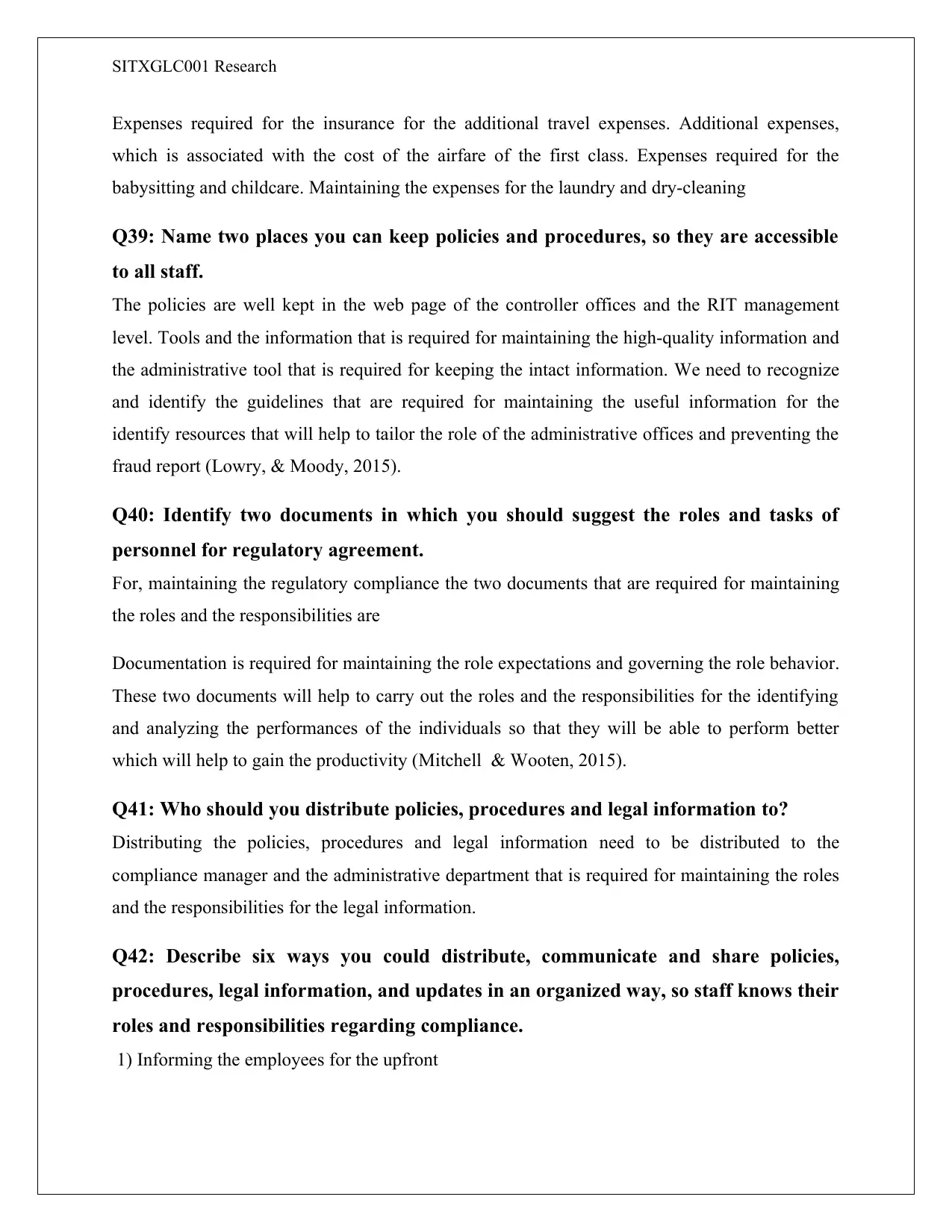
SITXGLC001 Research
Expenses required for the insurance for the additional travel expenses. Additional expenses,
which is associated with the cost of the airfare of the first class. Expenses required for the
babysitting and childcare. Maintaining the expenses for the laundry and dry-cleaning
Q39: Name two places you can keep policies and procedures, so they are accessible
to all staff.
The policies are well kept in the web page of the controller offices and the RIT management
level. Tools and the information that is required for maintaining the high-quality information and
the administrative tool that is required for keeping the intact information. We need to recognize
and identify the guidelines that are required for maintaining the useful information for the
identify resources that will help to tailor the role of the administrative offices and preventing the
fraud report (Lowry, & Moody, 2015).
Q40: Identify two documents in which you should suggest the roles and tasks of
personnel for regulatory agreement.
For, maintaining the regulatory compliance the two documents that are required for maintaining
the roles and the responsibilities are
Documentation is required for maintaining the role expectations and governing the role behavior.
These two documents will help to carry out the roles and the responsibilities for the identifying
and analyzing the performances of the individuals so that they will be able to perform better
which will help to gain the productivity (Mitchell & Wooten, 2015).
Q41: Who should you distribute policies, procedures and legal information to?
Distributing the policies, procedures and legal information need to be distributed to the
compliance manager and the administrative department that is required for maintaining the roles
and the responsibilities for the legal information.
Q42: Describe six ways you could distribute, communicate and share policies,
procedures, legal information, and updates in an organized way, so staff knows their
roles and responsibilities regarding compliance.
1) Informing the employees for the upfront
Expenses required for the insurance for the additional travel expenses. Additional expenses,
which is associated with the cost of the airfare of the first class. Expenses required for the
babysitting and childcare. Maintaining the expenses for the laundry and dry-cleaning
Q39: Name two places you can keep policies and procedures, so they are accessible
to all staff.
The policies are well kept in the web page of the controller offices and the RIT management
level. Tools and the information that is required for maintaining the high-quality information and
the administrative tool that is required for keeping the intact information. We need to recognize
and identify the guidelines that are required for maintaining the useful information for the
identify resources that will help to tailor the role of the administrative offices and preventing the
fraud report (Lowry, & Moody, 2015).
Q40: Identify two documents in which you should suggest the roles and tasks of
personnel for regulatory agreement.
For, maintaining the regulatory compliance the two documents that are required for maintaining
the roles and the responsibilities are
Documentation is required for maintaining the role expectations and governing the role behavior.
These two documents will help to carry out the roles and the responsibilities for the identifying
and analyzing the performances of the individuals so that they will be able to perform better
which will help to gain the productivity (Mitchell & Wooten, 2015).
Q41: Who should you distribute policies, procedures and legal information to?
Distributing the policies, procedures and legal information need to be distributed to the
compliance manager and the administrative department that is required for maintaining the roles
and the responsibilities for the legal information.
Q42: Describe six ways you could distribute, communicate and share policies,
procedures, legal information, and updates in an organized way, so staff knows their
roles and responsibilities regarding compliance.
1) Informing the employees for the upfront

SITXGLC001 Research
1) Asking for the feedback for encouraging the employees that should be included under
the policy manual
2) Introducing the final product to introduce and completing the handbook for reviewing it
for the purpose
3) Asking the employees for reviewing the handbook and the policy manual which helps to
regulate and provide the feedback to the employees (Tyler & Jackson, 2014)
4) Providing the facilities for the training that is required for the extensive and the intensive
employees that will help to acquire for the need basis.
5) Requesting the signoff for the employees that are required to get familiar with the
policies of the Company (Dharshini, & Mehta, 2016).
Section 3: Ensure compliance with legal requirements
Q43: Youre planning to open a new restaurant. List six regulatory authorities you
might communicate with first.
According to Griffith, 2015, for opening a restaurant in Australia, the main governing bodies
that needed to be communicated are
1) Australian securities and the investments commission of Australia
2) Australian Securities Exchange (ASX)
3) Consumer commission of Australia and also to the Australian competition
4) Taxation office of Australia
5) Australian Transactions Reports and Analysis center (AUSTRAC)
6) The review board for the foreign investments (FIRB)
7) Therapeutic Goods Administration (TGA)
These are the regulatory bodies need to be communicated for opening up the restaurant.
Q. 44: A staff member is about to have a meeting with a representative of the WHS
authority to determine the scope of compliance requirements for the new
restaurant.
Provide them with seven communication tips.
1) Asking for the feedback for encouraging the employees that should be included under
the policy manual
2) Introducing the final product to introduce and completing the handbook for reviewing it
for the purpose
3) Asking the employees for reviewing the handbook and the policy manual which helps to
regulate and provide the feedback to the employees (Tyler & Jackson, 2014)
4) Providing the facilities for the training that is required for the extensive and the intensive
employees that will help to acquire for the need basis.
5) Requesting the signoff for the employees that are required to get familiar with the
policies of the Company (Dharshini, & Mehta, 2016).
Section 3: Ensure compliance with legal requirements
Q43: Youre planning to open a new restaurant. List six regulatory authorities you
might communicate with first.
According to Griffith, 2015, for opening a restaurant in Australia, the main governing bodies
that needed to be communicated are
1) Australian securities and the investments commission of Australia
2) Australian Securities Exchange (ASX)
3) Consumer commission of Australia and also to the Australian competition
4) Taxation office of Australia
5) Australian Transactions Reports and Analysis center (AUSTRAC)
6) The review board for the foreign investments (FIRB)
7) Therapeutic Goods Administration (TGA)
These are the regulatory bodies need to be communicated for opening up the restaurant.
Q. 44: A staff member is about to have a meeting with a representative of the WHS
authority to determine the scope of compliance requirements for the new
restaurant.
Provide them with seven communication tips.
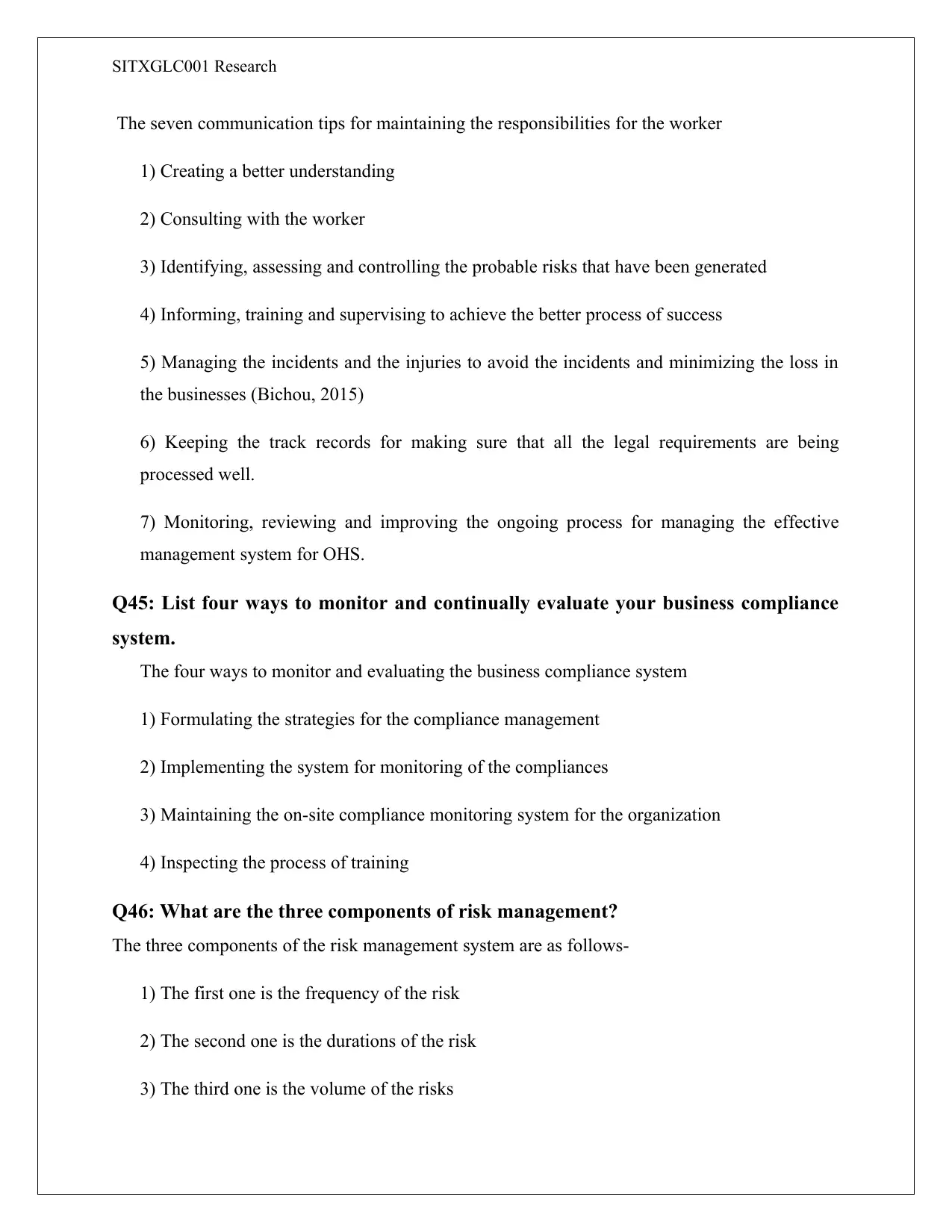
SITXGLC001 Research
The seven communication tips for maintaining the responsibilities for the worker
1) Creating a better understanding
2) Consulting with the worker
3) Identifying, assessing and controlling the probable risks that have been generated
4) Informing, training and supervising to achieve the better process of success
5) Managing the incidents and the injuries to avoid the incidents and minimizing the loss in
the businesses (Bichou, 2015)
6) Keeping the track records for making sure that all the legal requirements are being
processed well.
7) Monitoring, reviewing and improving the ongoing process for managing the effective
management system for OHS.
Q45: List four ways to monitor and continually evaluate your business compliance
system.
The four ways to monitor and evaluating the business compliance system
1) Formulating the strategies for the compliance management
2) Implementing the system for monitoring of the compliances
3) Maintaining the on-site compliance monitoring system for the organization
4) Inspecting the process of training
Q46: What are the three components of risk management?
The three components of the risk management system are as follows-
1) The first one is the frequency of the risk
2) The second one is the durations of the risk
3) The third one is the volume of the risks
The seven communication tips for maintaining the responsibilities for the worker
1) Creating a better understanding
2) Consulting with the worker
3) Identifying, assessing and controlling the probable risks that have been generated
4) Informing, training and supervising to achieve the better process of success
5) Managing the incidents and the injuries to avoid the incidents and minimizing the loss in
the businesses (Bichou, 2015)
6) Keeping the track records for making sure that all the legal requirements are being
processed well.
7) Monitoring, reviewing and improving the ongoing process for managing the effective
management system for OHS.
Q45: List four ways to monitor and continually evaluate your business compliance
system.
The four ways to monitor and evaluating the business compliance system
1) Formulating the strategies for the compliance management
2) Implementing the system for monitoring of the compliances
3) Maintaining the on-site compliance monitoring system for the organization
4) Inspecting the process of training
Q46: What are the three components of risk management?
The three components of the risk management system are as follows-
1) The first one is the frequency of the risk
2) The second one is the durations of the risk
3) The third one is the volume of the risks
Secure Best Marks with AI Grader
Need help grading? Try our AI Grader for instant feedback on your assignments.
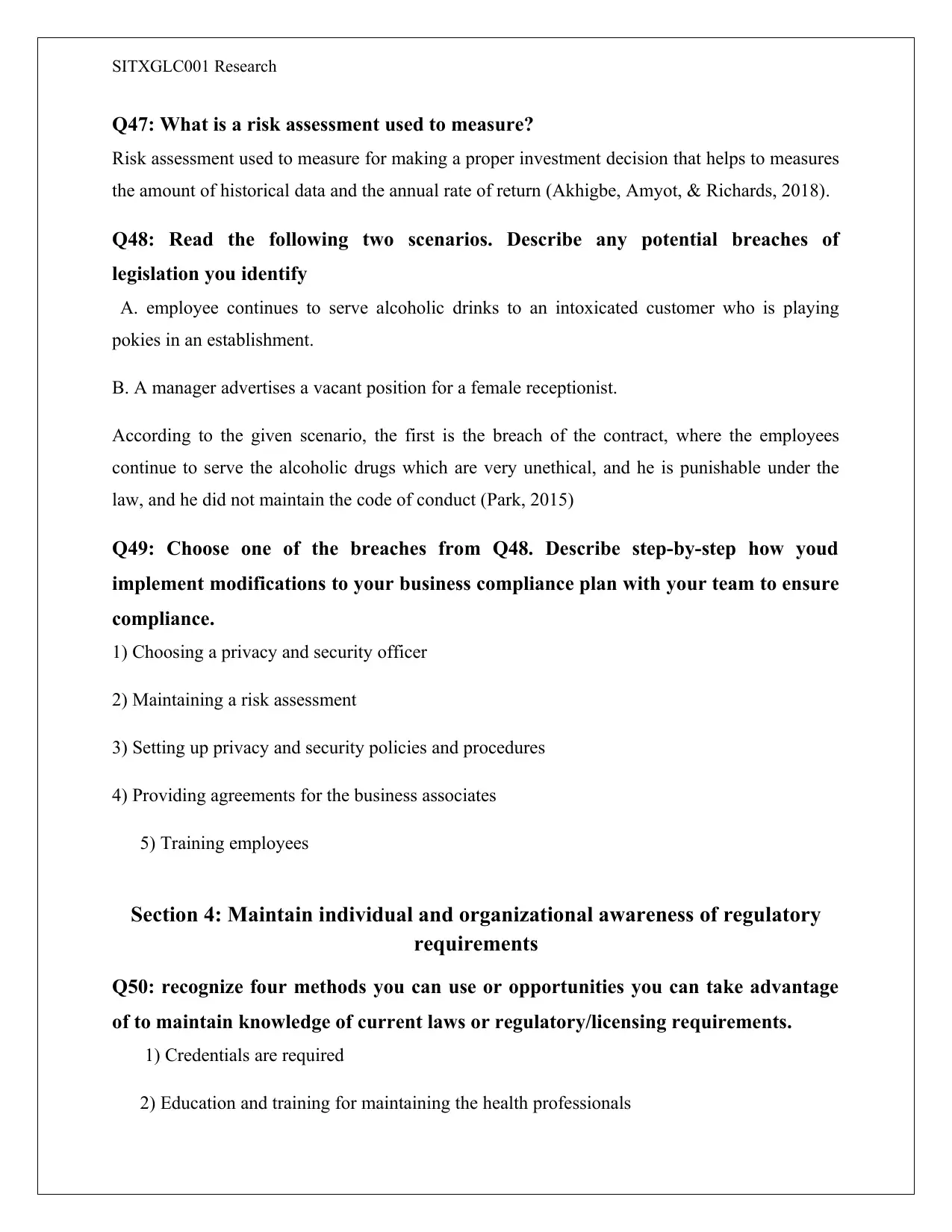
SITXGLC001 Research
Q47: What is a risk assessment used to measure?
Risk assessment used to measure for making a proper investment decision that helps to measures
the amount of historical data and the annual rate of return (Akhigbe, Amyot, & Richards, 2018).
Q48: Read the following two scenarios. Describe any potential breaches of
legislation you identify
A. employee continues to serve alcoholic drinks to an intoxicated customer who is playing
pokies in an establishment.
B. A manager advertises a vacant position for a female receptionist.
According to the given scenario, the first is the breach of the contract, where the employees
continue to serve the alcoholic drugs which are very unethical, and he is punishable under the
law, and he did not maintain the code of conduct (Park, 2015)
Q49: Choose one of the breaches from Q48. Describe step-by-step how youd
implement modifications to your business compliance plan with your team to ensure
compliance.
1) Choosing a privacy and security officer
2) Maintaining a risk assessment
3) Setting up privacy and security policies and procedures
4) Providing agreements for the business associates
5) Training employees
Section 4: Maintain individual and organizational awareness of regulatory
requirements
Q50: recognize four methods you can use or opportunities you can take advantage
of to maintain knowledge of current laws or regulatory/licensing requirements.
1) Credentials are required
2) Education and training for maintaining the health professionals
Q47: What is a risk assessment used to measure?
Risk assessment used to measure for making a proper investment decision that helps to measures
the amount of historical data and the annual rate of return (Akhigbe, Amyot, & Richards, 2018).
Q48: Read the following two scenarios. Describe any potential breaches of
legislation you identify
A. employee continues to serve alcoholic drinks to an intoxicated customer who is playing
pokies in an establishment.
B. A manager advertises a vacant position for a female receptionist.
According to the given scenario, the first is the breach of the contract, where the employees
continue to serve the alcoholic drugs which are very unethical, and he is punishable under the
law, and he did not maintain the code of conduct (Park, 2015)
Q49: Choose one of the breaches from Q48. Describe step-by-step how youd
implement modifications to your business compliance plan with your team to ensure
compliance.
1) Choosing a privacy and security officer
2) Maintaining a risk assessment
3) Setting up privacy and security policies and procedures
4) Providing agreements for the business associates
5) Training employees
Section 4: Maintain individual and organizational awareness of regulatory
requirements
Q50: recognize four methods you can use or opportunities you can take advantage
of to maintain knowledge of current laws or regulatory/licensing requirements.
1) Credentials are required
2) Education and training for maintaining the health professionals
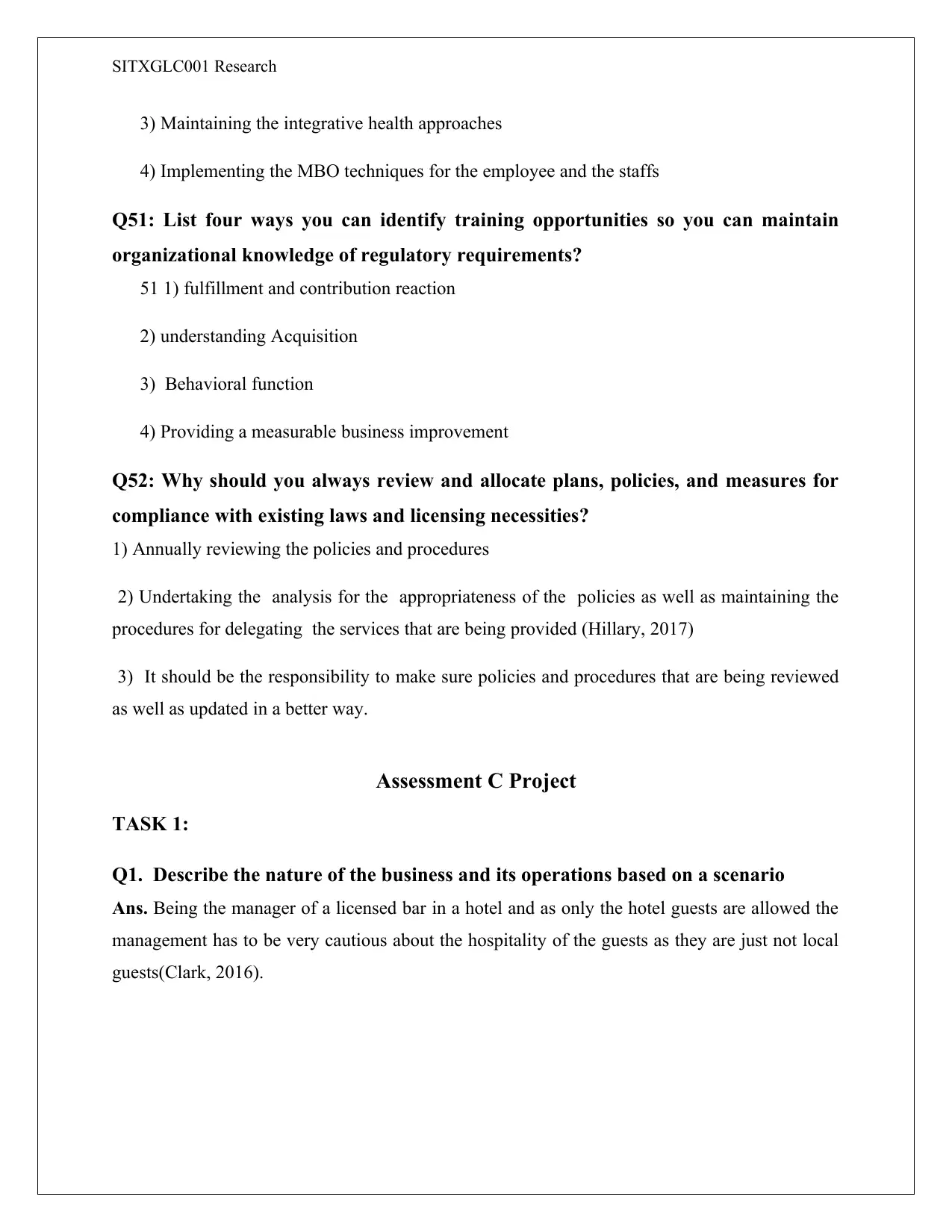
SITXGLC001 Research
3) Maintaining the integrative health approaches
4) Implementing the MBO techniques for the employee and the staffs
Q51: List four ways you can identify training opportunities so you can maintain
organizational knowledge of regulatory requirements?
51 1) fulfillment and contribution reaction
2) understanding Acquisition
3) Behavioral function
4) Providing a measurable business improvement
Q52: Why should you always review and allocate plans, policies, and measures for
compliance with existing laws and licensing necessities?
1) Annually reviewing the policies and procedures
2) Undertaking the analysis for the appropriateness of the policies as well as maintaining the
procedures for delegating the services that are being provided (Hillary, 2017)
3) It should be the responsibility to make sure policies and procedures that are being reviewed
as well as updated in a better way.
Assessment C Project
TASK 1:
Q1. Describe the nature of the business and its operations based on a scenario
Ans. Being the manager of a licensed bar in a hotel and as only the hotel guests are allowed the
management has to be very cautious about the hospitality of the guests as they are just not local
guests(Clark, 2016).
3) Maintaining the integrative health approaches
4) Implementing the MBO techniques for the employee and the staffs
Q51: List four ways you can identify training opportunities so you can maintain
organizational knowledge of regulatory requirements?
51 1) fulfillment and contribution reaction
2) understanding Acquisition
3) Behavioral function
4) Providing a measurable business improvement
Q52: Why should you always review and allocate plans, policies, and measures for
compliance with existing laws and licensing necessities?
1) Annually reviewing the policies and procedures
2) Undertaking the analysis for the appropriateness of the policies as well as maintaining the
procedures for delegating the services that are being provided (Hillary, 2017)
3) It should be the responsibility to make sure policies and procedures that are being reviewed
as well as updated in a better way.
Assessment C Project
TASK 1:
Q1. Describe the nature of the business and its operations based on a scenario
Ans. Being the manager of a licensed bar in a hotel and as only the hotel guests are allowed the
management has to be very cautious about the hospitality of the guests as they are just not local
guests(Clark, 2016).

SITXGLC001 Research
Q2. The responsibility of creating and planning the full compliance system of the
bar regarding establishment compliance
Ans. In a bar maintaining the compliance is very important and priority as it involves state
regulations, hotel regulations and a separate regulation of the bar. And give proper service to the
guests (da Silva Barboza, Gilberto, Filho, & de Souza, 2014).
Q3. Research regulatory requirements area
Ans 1. Contracts
2. Environmental protection
3. Liquor licensing and RSA
4. Insurances
5. WHS
Q4. List of laws
Ans. The main laws are-
1. Tax and trade bureau of the state
2. Department of alcoholic beverage control in the local area
TASK 1.1:
Q1. List of contacted authorities
Ans. The tax department of Europe, the liquor control department at a local level and a state
level, insurance department to provide insurance to the employees and the hotel as well. The
liquor trade license source had to be accessed, and the security department was also accessed
(Gittings and Cook, 2018).
Q2. Legal advice specialist
Ans. Needed advice on all the insurances and licensing that are required in a bar. Contacted the
lawyer who advised about the different licenses that are required to maintain the regulations and
Q2. The responsibility of creating and planning the full compliance system of the
bar regarding establishment compliance
Ans. In a bar maintaining the compliance is very important and priority as it involves state
regulations, hotel regulations and a separate regulation of the bar. And give proper service to the
guests (da Silva Barboza, Gilberto, Filho, & de Souza, 2014).
Q3. Research regulatory requirements area
Ans 1. Contracts
2. Environmental protection
3. Liquor licensing and RSA
4. Insurances
5. WHS
Q4. List of laws
Ans. The main laws are-
1. Tax and trade bureau of the state
2. Department of alcoholic beverage control in the local area
TASK 1.1:
Q1. List of contacted authorities
Ans. The tax department of Europe, the liquor control department at a local level and a state
level, insurance department to provide insurance to the employees and the hotel as well. The
liquor trade license source had to be accessed, and the security department was also accessed
(Gittings and Cook, 2018).
Q2. Legal advice specialist
Ans. Needed advice on all the insurances and licensing that are required in a bar. Contacted the
lawyer who advised about the different licenses that are required to maintain the regulations and
Paraphrase This Document
Need a fresh take? Get an instant paraphrase of this document with our AI Paraphraser
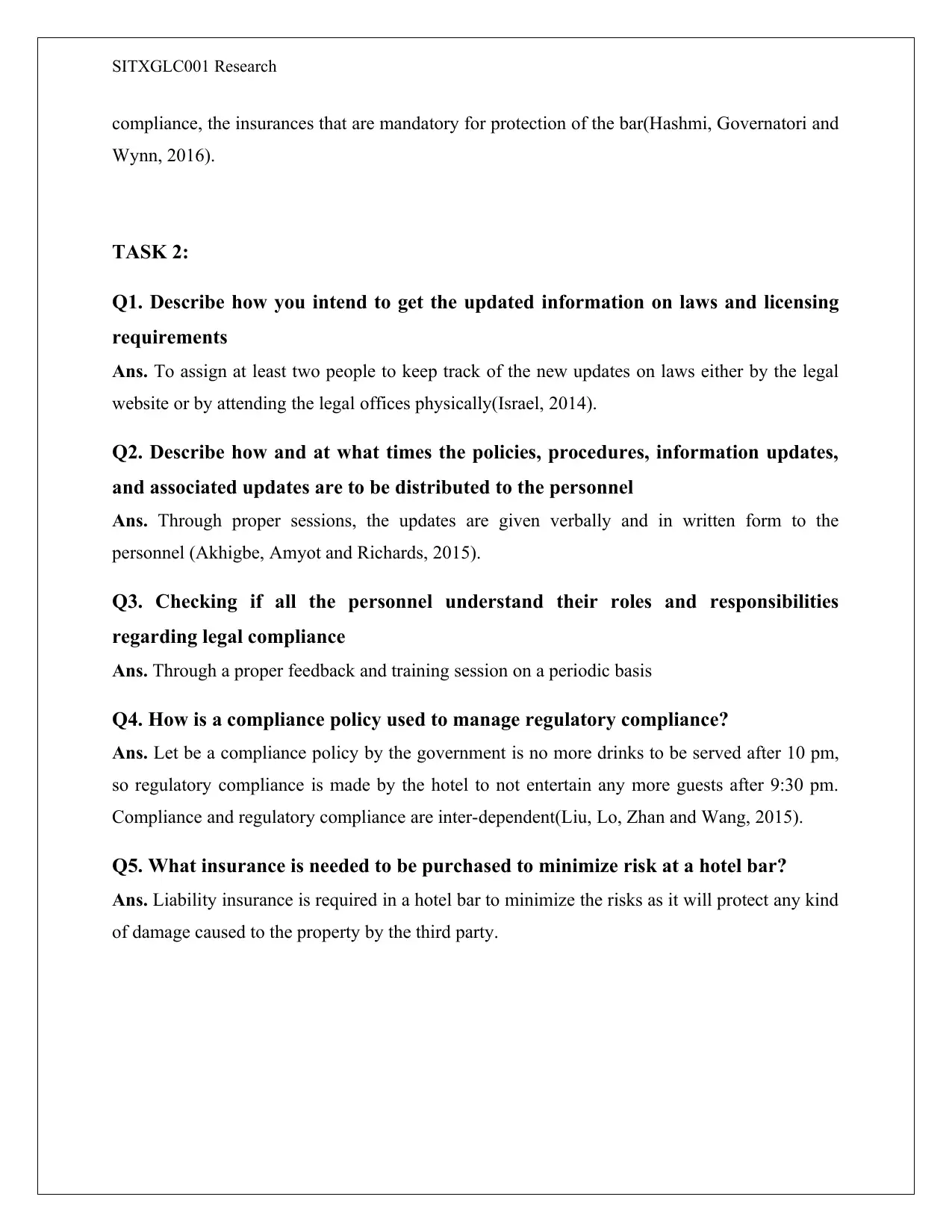
SITXGLC001 Research
compliance, the insurances that are mandatory for protection of the bar(Hashmi, Governatori and
Wynn, 2016).
TASK 2:
Q1. Describe how you intend to get the updated information on laws and licensing
requirements
Ans. To assign at least two people to keep track of the new updates on laws either by the legal
website or by attending the legal offices physically(Israel, 2014).
Q2. Describe how and at what times the policies, procedures, information updates,
and associated updates are to be distributed to the personnel
Ans. Through proper sessions, the updates are given verbally and in written form to the
personnel (Akhigbe, Amyot and Richards, 2015).
Q3. Checking if all the personnel understand their roles and responsibilities
regarding legal compliance
Ans. Through a proper feedback and training session on a periodic basis
Q4. How is a compliance policy used to manage regulatory compliance?
Ans. Let be a compliance policy by the government is no more drinks to be served after 10 pm,
so regulatory compliance is made by the hotel to not entertain any more guests after 9:30 pm.
Compliance and regulatory compliance are inter-dependent(Liu, Lo, Zhan and Wang, 2015).
Q5. What insurance is needed to be purchased to minimize risk at a hotel bar?
Ans. Liability insurance is required in a hotel bar to minimize the risks as it will protect any kind
of damage caused to the property by the third party.
compliance, the insurances that are mandatory for protection of the bar(Hashmi, Governatori and
Wynn, 2016).
TASK 2:
Q1. Describe how you intend to get the updated information on laws and licensing
requirements
Ans. To assign at least two people to keep track of the new updates on laws either by the legal
website or by attending the legal offices physically(Israel, 2014).
Q2. Describe how and at what times the policies, procedures, information updates,
and associated updates are to be distributed to the personnel
Ans. Through proper sessions, the updates are given verbally and in written form to the
personnel (Akhigbe, Amyot and Richards, 2015).
Q3. Checking if all the personnel understand their roles and responsibilities
regarding legal compliance
Ans. Through a proper feedback and training session on a periodic basis
Q4. How is a compliance policy used to manage regulatory compliance?
Ans. Let be a compliance policy by the government is no more drinks to be served after 10 pm,
so regulatory compliance is made by the hotel to not entertain any more guests after 9:30 pm.
Compliance and regulatory compliance are inter-dependent(Liu, Lo, Zhan and Wang, 2015).
Q5. What insurance is needed to be purchased to minimize risk at a hotel bar?
Ans. Liability insurance is required in a hotel bar to minimize the risks as it will protect any kind
of damage caused to the property by the third party.
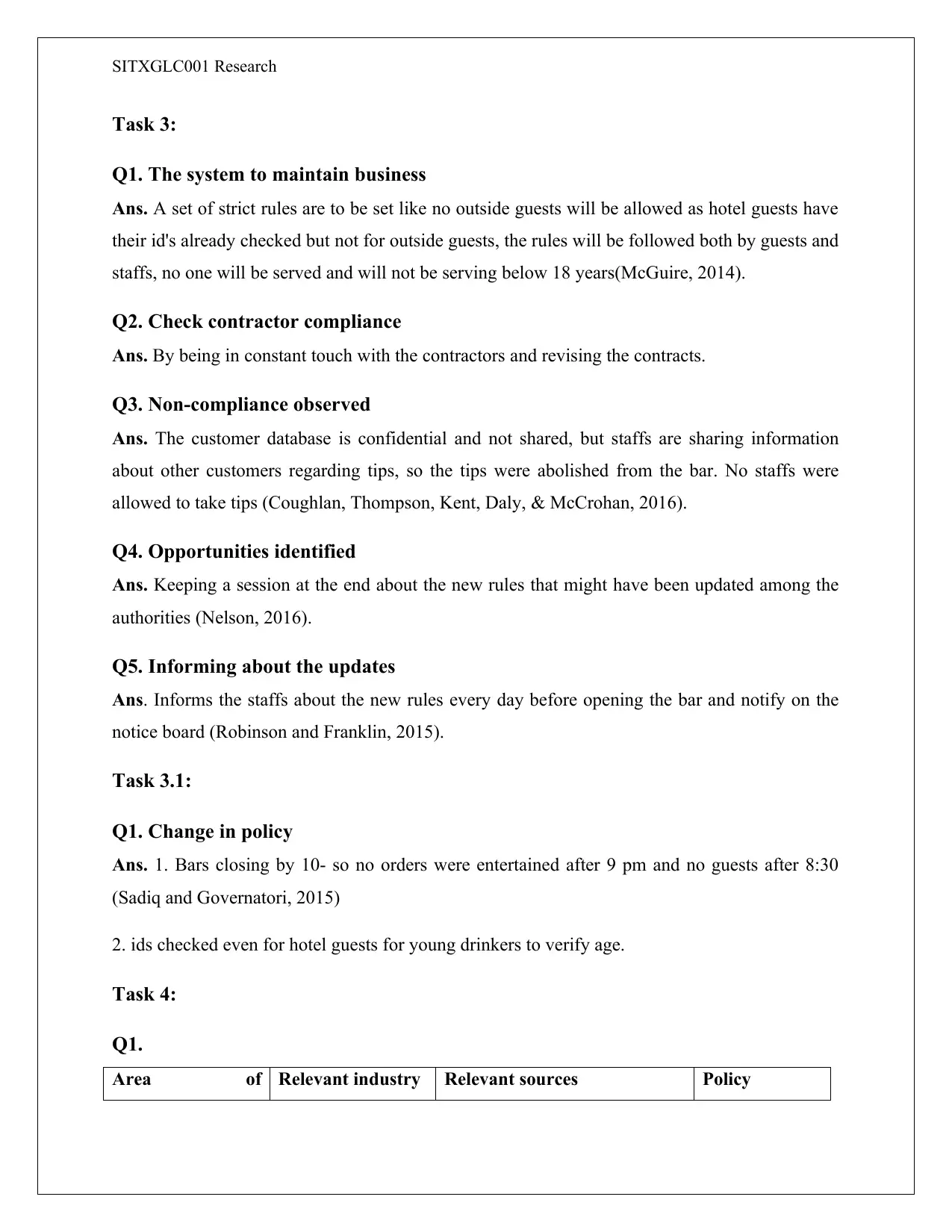
SITXGLC001 Research
Task 3:
Q1. The system to maintain business
Ans. A set of strict rules are to be set like no outside guests will be allowed as hotel guests have
their id's already checked but not for outside guests, the rules will be followed both by guests and
staffs, no one will be served and will not be serving below 18 years(McGuire, 2014).
Q2. Check contractor compliance
Ans. By being in constant touch with the contractors and revising the contracts.
Q3. Non-compliance observed
Ans. The customer database is confidential and not shared, but staffs are sharing information
about other customers regarding tips, so the tips were abolished from the bar. No staffs were
allowed to take tips (Coughlan, Thompson, Kent, Daly, & McCrohan, 2016).
Q4. Opportunities identified
Ans. Keeping a session at the end about the new rules that might have been updated among the
authorities (Nelson, 2016).
Q5. Informing about the updates
Ans. Informs the staffs about the new rules every day before opening the bar and notify on the
notice board (Robinson and Franklin, 2015).
Task 3.1:
Q1. Change in policy
Ans. 1. Bars closing by 10- so no orders were entertained after 9 pm and no guests after 8:30
(Sadiq and Governatori, 2015)
2. ids checked even for hotel guests for young drinkers to verify age.
Task 4:
Q1.
Area of Relevant industry Relevant sources Policy
Task 3:
Q1. The system to maintain business
Ans. A set of strict rules are to be set like no outside guests will be allowed as hotel guests have
their id's already checked but not for outside guests, the rules will be followed both by guests and
staffs, no one will be served and will not be serving below 18 years(McGuire, 2014).
Q2. Check contractor compliance
Ans. By being in constant touch with the contractors and revising the contracts.
Q3. Non-compliance observed
Ans. The customer database is confidential and not shared, but staffs are sharing information
about other customers regarding tips, so the tips were abolished from the bar. No staffs were
allowed to take tips (Coughlan, Thompson, Kent, Daly, & McCrohan, 2016).
Q4. Opportunities identified
Ans. Keeping a session at the end about the new rules that might have been updated among the
authorities (Nelson, 2016).
Q5. Informing about the updates
Ans. Informs the staffs about the new rules every day before opening the bar and notify on the
notice board (Robinson and Franklin, 2015).
Task 3.1:
Q1. Change in policy
Ans. 1. Bars closing by 10- so no orders were entertained after 9 pm and no guests after 8:30
(Sadiq and Governatori, 2015)
2. ids checked even for hotel guests for young drinkers to verify age.
Task 4:
Q1.
Area of Relevant industry Relevant sources Policy
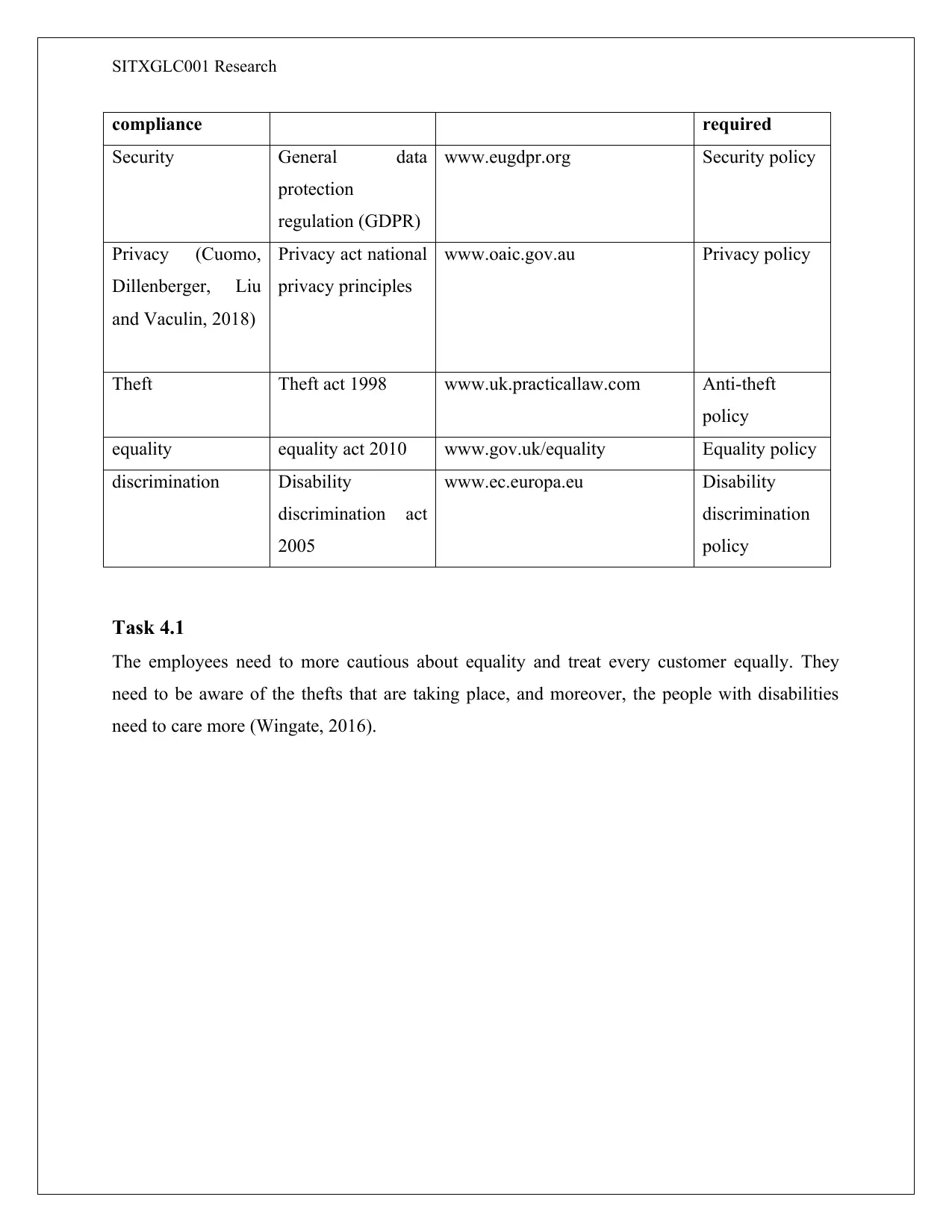
SITXGLC001 Research
compliance required
Security General data
protection
regulation (GDPR)
www.eugdpr.org Security policy
Privacy (Cuomo,
Dillenberger, Liu
and Vaculin, 2018)
Privacy act national
privacy principles
www.oaic.gov.au Privacy policy
Theft Theft act 1998 www.uk.practicallaw.com Anti-theft
policy
equality equality act 2010 www.gov.uk/equality Equality policy
discrimination Disability
discrimination act
2005
www.ec.europa.eu Disability
discrimination
policy
Task 4.1
The employees need to more cautious about equality and treat every customer equally. They
need to be aware of the thefts that are taking place, and moreover, the people with disabilities
need to care more (Wingate, 2016).
compliance required
Security General data
protection
regulation (GDPR)
www.eugdpr.org Security policy
Privacy (Cuomo,
Dillenberger, Liu
and Vaculin, 2018)
Privacy act national
privacy principles
www.oaic.gov.au Privacy policy
Theft Theft act 1998 www.uk.practicallaw.com Anti-theft
policy
equality equality act 2010 www.gov.uk/equality Equality policy
discrimination Disability
discrimination act
2005
www.ec.europa.eu Disability
discrimination
policy
Task 4.1
The employees need to more cautious about equality and treat every customer equally. They
need to be aware of the thefts that are taking place, and moreover, the people with disabilities
need to care more (Wingate, 2016).
Secure Best Marks with AI Grader
Need help grading? Try our AI Grader for instant feedback on your assignments.

SITXGLC001 Research
Reference list
Akhigbe, O., Amyot, D., & Richards, G. (2015, May). Information technology artifacts in the
regulatory compliance of business processes: a meta-analysis. In International
Conference on E-Technologies (pp. 89-104). Springer, Cham.
Akhigbe, O., Amyot, D., & Richards, G. (2018). A systematic literature mapping of goal and
non-goal modeling methods for legal and regulatory compliance. Requirements
Engineering, 1-23.
Bartolini, C., Giurgiu, A., Lenzini, G., & Robaldo, L. (2016). A Framework to Reason about the
Legal Compliance of Security Standards. In Proceedings of the Tenth International
Workshop on Juris-informatics (JURISIN).
Bichou, K. (2015). The ISPS code and the cost of port compliance: an initial logistics and supply
chain framework for port security assessment and management. In Port Management (pp.
109-137). Palgrave Macmillan, London.
Clark, B. T. (2016). U.S. Patent Application No. 15/097,187.
Coughlan, J. J., Thompson, N., Kent, J., Daly, K., & McCrohan, J. (2016). Increasing the
compliance rates of Medical Council Registration Number documentation in
AMNCH. Irish medical journal, 109(6), 432-432.
Cuomo, G. A., Dillenberger, D. N., Liu, R., & Vaculin, R. (2018). U.S. Patent Application No.
15/462,875.
Da Silva Barboza, L., Gilberto Filho, A. D. A., & de Souza, R. A. (2014, August). Towards a
legal compliance verification approach on the procurement process of IT solutions for the
Brazilian Federal Public Administration. In Requirements Engineering and Law
(RELAW), 2014 IEEE 7th International Workshop on (pp. 39-40). IEEE.
Dharshini, N. S., & Mehta, K. J. (2016). Octapace Culture Profiling-A Study among Employees
Working in a Legal Compliance Firm in Madurai. TSM Business Review, 4(2), 49.
Reference list
Akhigbe, O., Amyot, D., & Richards, G. (2015, May). Information technology artifacts in the
regulatory compliance of business processes: a meta-analysis. In International
Conference on E-Technologies (pp. 89-104). Springer, Cham.
Akhigbe, O., Amyot, D., & Richards, G. (2018). A systematic literature mapping of goal and
non-goal modeling methods for legal and regulatory compliance. Requirements
Engineering, 1-23.
Bartolini, C., Giurgiu, A., Lenzini, G., & Robaldo, L. (2016). A Framework to Reason about the
Legal Compliance of Security Standards. In Proceedings of the Tenth International
Workshop on Juris-informatics (JURISIN).
Bichou, K. (2015). The ISPS code and the cost of port compliance: an initial logistics and supply
chain framework for port security assessment and management. In Port Management (pp.
109-137). Palgrave Macmillan, London.
Clark, B. T. (2016). U.S. Patent Application No. 15/097,187.
Coughlan, J. J., Thompson, N., Kent, J., Daly, K., & McCrohan, J. (2016). Increasing the
compliance rates of Medical Council Registration Number documentation in
AMNCH. Irish medical journal, 109(6), 432-432.
Cuomo, G. A., Dillenberger, D. N., Liu, R., & Vaculin, R. (2018). U.S. Patent Application No.
15/462,875.
Da Silva Barboza, L., Gilberto Filho, A. D. A., & de Souza, R. A. (2014, August). Towards a
legal compliance verification approach on the procurement process of IT solutions for the
Brazilian Federal Public Administration. In Requirements Engineering and Law
(RELAW), 2014 IEEE 7th International Workshop on (pp. 39-40). IEEE.
Dharshini, N. S., & Mehta, K. J. (2016). Octapace Culture Profiling-A Study among Employees
Working in a Legal Compliance Firm in Madurai. TSM Business Review, 4(2), 49.

SITXGLC001 Research
Ghanavati, S., & Hulstijn, J. (2015, May). Impact of legal interpretation on business process
compliance. In Proceedings of the First International Workshop on TEchnical and LEgal
aspects of data pRIvacy (pp. 26-31). IEEE Press.
Gittings, D., & Cook, B. (2018). U.S. Patent Application No. 16/028,873.
Griffith, S. J. (2015). Corporate Governance in an Era of Compliance. Wm. & Mary L. Rev., 57,
2075.
Hashmi, M., Governatori, G., & Wynn, M. T. (2016). Normative requirements for regulatory
compliance: An abstract formal framework. Information Systems Frontiers, 18(3), 429-
455.
Hillary, R. (2017). Introduction. In ISO 14001 (pp. 11-16). Routledge.
Holcomb, J. M. (2016). Corporate Governance: Ethics and Legal Compliance, Risk
Management, and Political Activities. The Handbook of Board Governance: A
Comprehensive Guide for Public, Private and Not‐for‐Profit Board Members, 683-702.
Holcomb, J. M. (2016). Corporate Governance: Ethics and Legal Compliance, Risk
Management, and Political Activities. The Handbook of Board Governance: A
Comprehensive Guide for Public, Private and Not‐for‐Profit Board Members, 683-702.
Israel, M. (2014). Research ethics and integrity for social scientists: Beyond regulatory
compliance. Sage.
Jackson, J., & Gau, J. M. (2016). Carving up concepts? Differentiating between trust and
legitimacy in public attitudes towards legal authority. In Interdisciplinary perspectives on
trust (pp. 49-69). Springer, Cham.
Kagan, R. A., Thornton, D., & Cunningham, N. A. (2017). Motivating management: Corporate
compliance in environmental protection. In Crime and Regulation (pp. 203-230).
Routledge.
Ghanavati, S., & Hulstijn, J. (2015, May). Impact of legal interpretation on business process
compliance. In Proceedings of the First International Workshop on TEchnical and LEgal
aspects of data pRIvacy (pp. 26-31). IEEE Press.
Gittings, D., & Cook, B. (2018). U.S. Patent Application No. 16/028,873.
Griffith, S. J. (2015). Corporate Governance in an Era of Compliance. Wm. & Mary L. Rev., 57,
2075.
Hashmi, M., Governatori, G., & Wynn, M. T. (2016). Normative requirements for regulatory
compliance: An abstract formal framework. Information Systems Frontiers, 18(3), 429-
455.
Hillary, R. (2017). Introduction. In ISO 14001 (pp. 11-16). Routledge.
Holcomb, J. M. (2016). Corporate Governance: Ethics and Legal Compliance, Risk
Management, and Political Activities. The Handbook of Board Governance: A
Comprehensive Guide for Public, Private and Not‐for‐Profit Board Members, 683-702.
Holcomb, J. M. (2016). Corporate Governance: Ethics and Legal Compliance, Risk
Management, and Political Activities. The Handbook of Board Governance: A
Comprehensive Guide for Public, Private and Not‐for‐Profit Board Members, 683-702.
Israel, M. (2014). Research ethics and integrity for social scientists: Beyond regulatory
compliance. Sage.
Jackson, J., & Gau, J. M. (2016). Carving up concepts? Differentiating between trust and
legitimacy in public attitudes towards legal authority. In Interdisciplinary perspectives on
trust (pp. 49-69). Springer, Cham.
Kagan, R. A., Thornton, D., & Cunningham, N. A. (2017). Motivating management: Corporate
compliance in environmental protection. In Crime and Regulation (pp. 203-230).
Routledge.
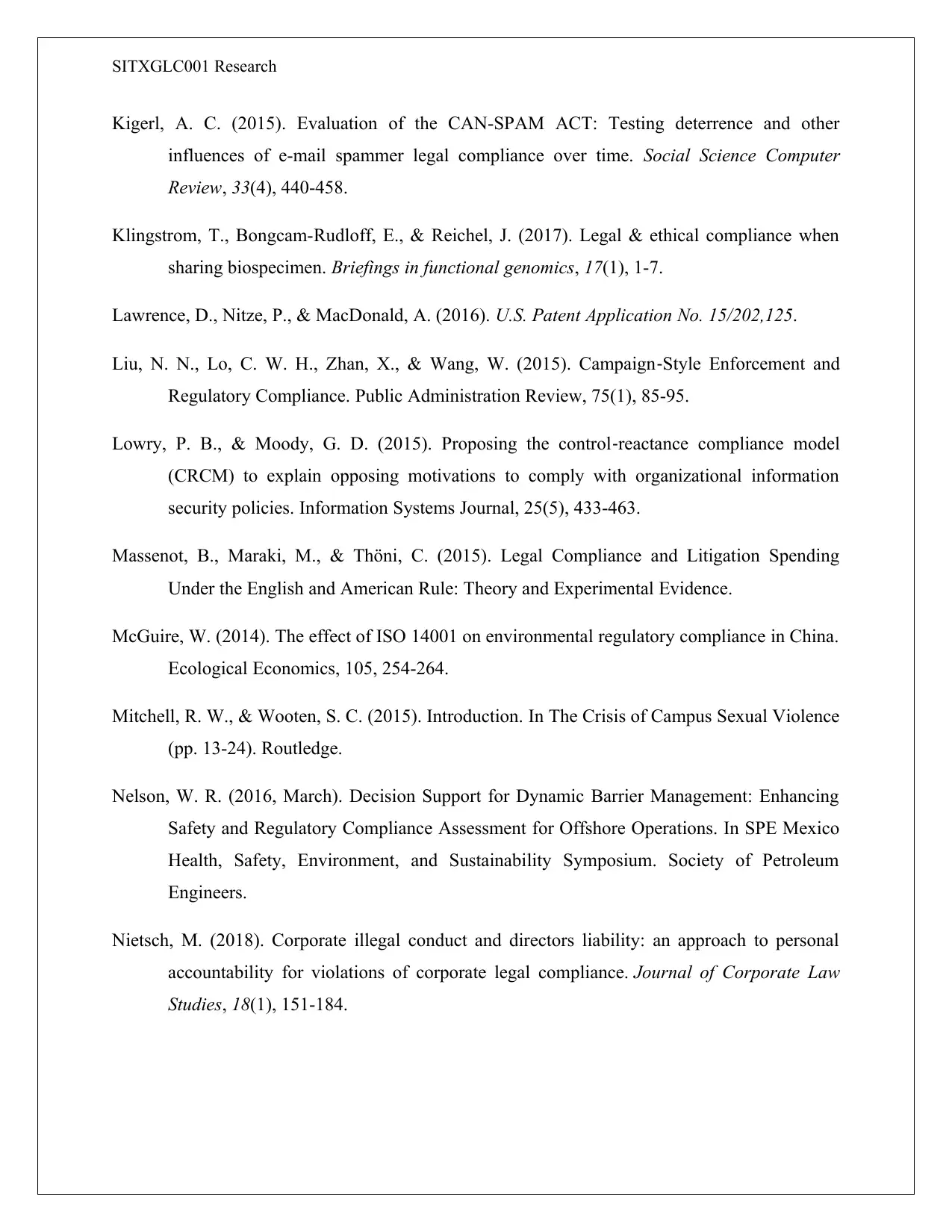
SITXGLC001 Research
Kigerl, A. C. (2015). Evaluation of the CAN-SPAM ACT: Testing deterrence and other
influences of e-mail spammer legal compliance over time. Social Science Computer
Review, 33(4), 440-458.
Klingstrom, T., Bongcam-Rudloff, E., & Reichel, J. (2017). Legal & ethical compliance when
sharing biospecimen. Briefings in functional genomics, 17(1), 1-7.
Lawrence, D., Nitze, P., & MacDonald, A. (2016). U.S. Patent Application No. 15/202,125.
Liu, N. N., Lo, C. W. H., Zhan, X., & Wang, W. (2015). Campaign‐Style Enforcement and
Regulatory Compliance. Public Administration Review, 75(1), 85-95.
Lowry, P. B., & Moody, G. D. (2015). Proposing the control‐reactance compliance model
(CRCM) to explain opposing motivations to comply with organizational information
security policies. Information Systems Journal, 25(5), 433-463.
Massenot, B., Maraki, M., & Thöni, C. (2015). Legal Compliance and Litigation Spending
Under the English and American Rule: Theory and Experimental Evidence.
McGuire, W. (2014). The effect of ISO 14001 on environmental regulatory compliance in China.
Ecological Economics, 105, 254-264.
Mitchell, R. W., & Wooten, S. C. (2015). Introduction. In The Crisis of Campus Sexual Violence
(pp. 13-24). Routledge.
Nelson, W. R. (2016, March). Decision Support for Dynamic Barrier Management: Enhancing
Safety and Regulatory Compliance Assessment for Offshore Operations. In SPE Mexico
Health, Safety, Environment, and Sustainability Symposium. Society of Petroleum
Engineers.
Nietsch, M. (2018). Corporate illegal conduct and directors liability: an approach to personal
accountability for violations of corporate legal compliance. Journal of Corporate Law
Studies, 18(1), 151-184.
Kigerl, A. C. (2015). Evaluation of the CAN-SPAM ACT: Testing deterrence and other
influences of e-mail spammer legal compliance over time. Social Science Computer
Review, 33(4), 440-458.
Klingstrom, T., Bongcam-Rudloff, E., & Reichel, J. (2017). Legal & ethical compliance when
sharing biospecimen. Briefings in functional genomics, 17(1), 1-7.
Lawrence, D., Nitze, P., & MacDonald, A. (2016). U.S. Patent Application No. 15/202,125.
Liu, N. N., Lo, C. W. H., Zhan, X., & Wang, W. (2015). Campaign‐Style Enforcement and
Regulatory Compliance. Public Administration Review, 75(1), 85-95.
Lowry, P. B., & Moody, G. D. (2015). Proposing the control‐reactance compliance model
(CRCM) to explain opposing motivations to comply with organizational information
security policies. Information Systems Journal, 25(5), 433-463.
Massenot, B., Maraki, M., & Thöni, C. (2015). Legal Compliance and Litigation Spending
Under the English and American Rule: Theory and Experimental Evidence.
McGuire, W. (2014). The effect of ISO 14001 on environmental regulatory compliance in China.
Ecological Economics, 105, 254-264.
Mitchell, R. W., & Wooten, S. C. (2015). Introduction. In The Crisis of Campus Sexual Violence
(pp. 13-24). Routledge.
Nelson, W. R. (2016, March). Decision Support for Dynamic Barrier Management: Enhancing
Safety and Regulatory Compliance Assessment for Offshore Operations. In SPE Mexico
Health, Safety, Environment, and Sustainability Symposium. Society of Petroleum
Engineers.
Nietsch, M. (2018). Corporate illegal conduct and directors liability: an approach to personal
accountability for violations of corporate legal compliance. Journal of Corporate Law
Studies, 18(1), 151-184.
Paraphrase This Document
Need a fresh take? Get an instant paraphrase of this document with our AI Paraphraser
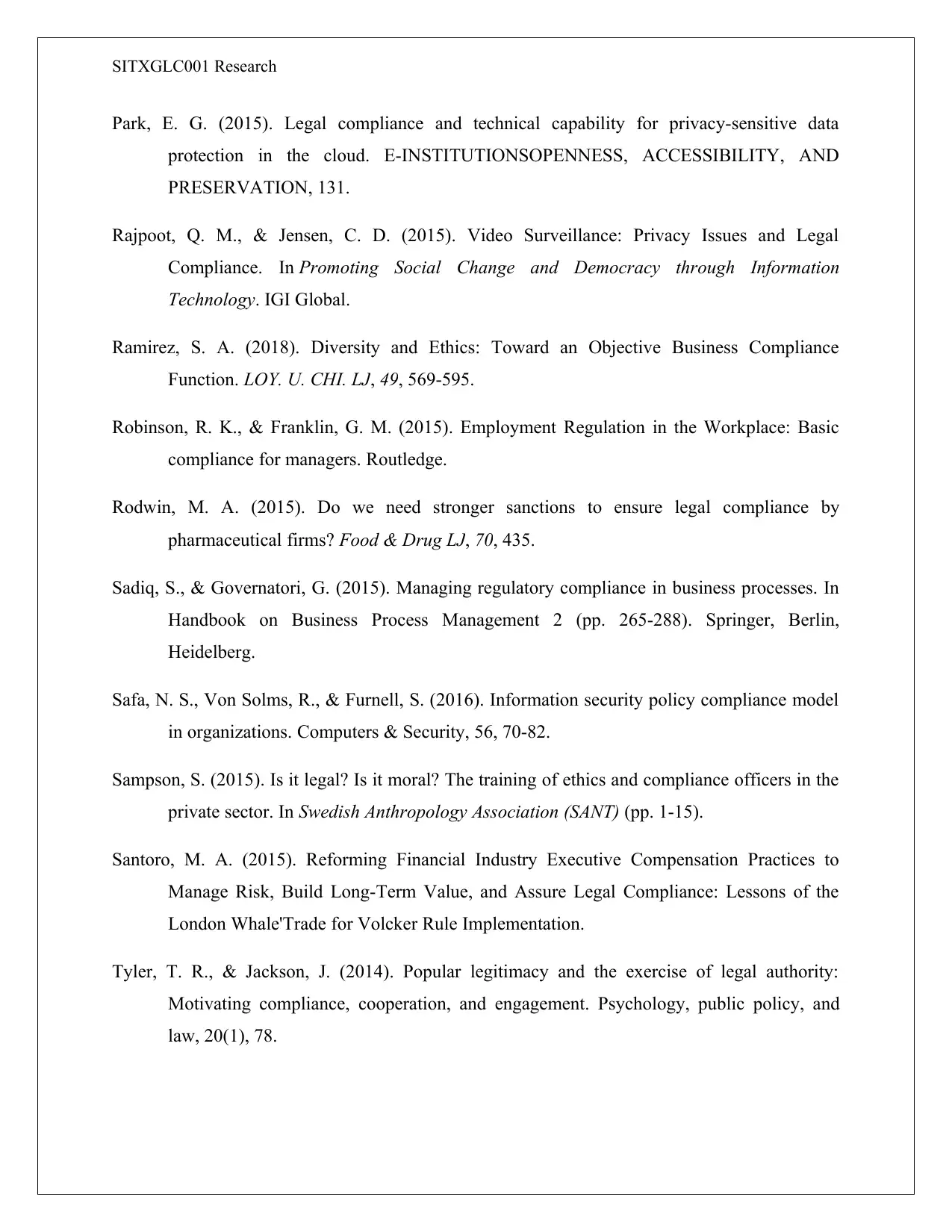
SITXGLC001 Research
Park, E. G. (2015). Legal compliance and technical capability for privacy-sensitive data
protection in the cloud. E-INSTITUTIONSOPENNESS, ACCESSIBILITY, AND
PRESERVATION, 131.
Rajpoot, Q. M., & Jensen, C. D. (2015). Video Surveillance: Privacy Issues and Legal
Compliance. In Promoting Social Change and Democracy through Information
Technology. IGI Global.
Ramirez, S. A. (2018). Diversity and Ethics: Toward an Objective Business Compliance
Function. LOY. U. CHI. LJ, 49, 569-595.
Robinson, R. K., & Franklin, G. M. (2015). Employment Regulation in the Workplace: Basic
compliance for managers. Routledge.
Rodwin, M. A. (2015). Do we need stronger sanctions to ensure legal compliance by
pharmaceutical firms? Food & Drug LJ, 70, 435.
Sadiq, S., & Governatori, G. (2015). Managing regulatory compliance in business processes. In
Handbook on Business Process Management 2 (pp. 265-288). Springer, Berlin,
Heidelberg.
Safa, N. S., Von Solms, R., & Furnell, S. (2016). Information security policy compliance model
in organizations. Computers & Security, 56, 70-82.
Sampson, S. (2015). Is it legal? Is it moral? The training of ethics and compliance officers in the
private sector. In Swedish Anthropology Association (SANT) (pp. 1-15).
Santoro, M. A. (2015). Reforming Financial Industry Executive Compensation Practices to
Manage Risk, Build Long-Term Value, and Assure Legal Compliance: Lessons of the
London Whale'Trade for Volcker Rule Implementation.
Tyler, T. R., & Jackson, J. (2014). Popular legitimacy and the exercise of legal authority:
Motivating compliance, cooperation, and engagement. Psychology, public policy, and
law, 20(1), 78.
Park, E. G. (2015). Legal compliance and technical capability for privacy-sensitive data
protection in the cloud. E-INSTITUTIONSOPENNESS, ACCESSIBILITY, AND
PRESERVATION, 131.
Rajpoot, Q. M., & Jensen, C. D. (2015). Video Surveillance: Privacy Issues and Legal
Compliance. In Promoting Social Change and Democracy through Information
Technology. IGI Global.
Ramirez, S. A. (2018). Diversity and Ethics: Toward an Objective Business Compliance
Function. LOY. U. CHI. LJ, 49, 569-595.
Robinson, R. K., & Franklin, G. M. (2015). Employment Regulation in the Workplace: Basic
compliance for managers. Routledge.
Rodwin, M. A. (2015). Do we need stronger sanctions to ensure legal compliance by
pharmaceutical firms? Food & Drug LJ, 70, 435.
Sadiq, S., & Governatori, G. (2015). Managing regulatory compliance in business processes. In
Handbook on Business Process Management 2 (pp. 265-288). Springer, Berlin,
Heidelberg.
Safa, N. S., Von Solms, R., & Furnell, S. (2016). Information security policy compliance model
in organizations. Computers & Security, 56, 70-82.
Sampson, S. (2015). Is it legal? Is it moral? The training of ethics and compliance officers in the
private sector. In Swedish Anthropology Association (SANT) (pp. 1-15).
Santoro, M. A. (2015). Reforming Financial Industry Executive Compensation Practices to
Manage Risk, Build Long-Term Value, and Assure Legal Compliance: Lessons of the
London Whale'Trade for Volcker Rule Implementation.
Tyler, T. R., & Jackson, J. (2014). Popular legitimacy and the exercise of legal authority:
Motivating compliance, cooperation, and engagement. Psychology, public policy, and
law, 20(1), 78.
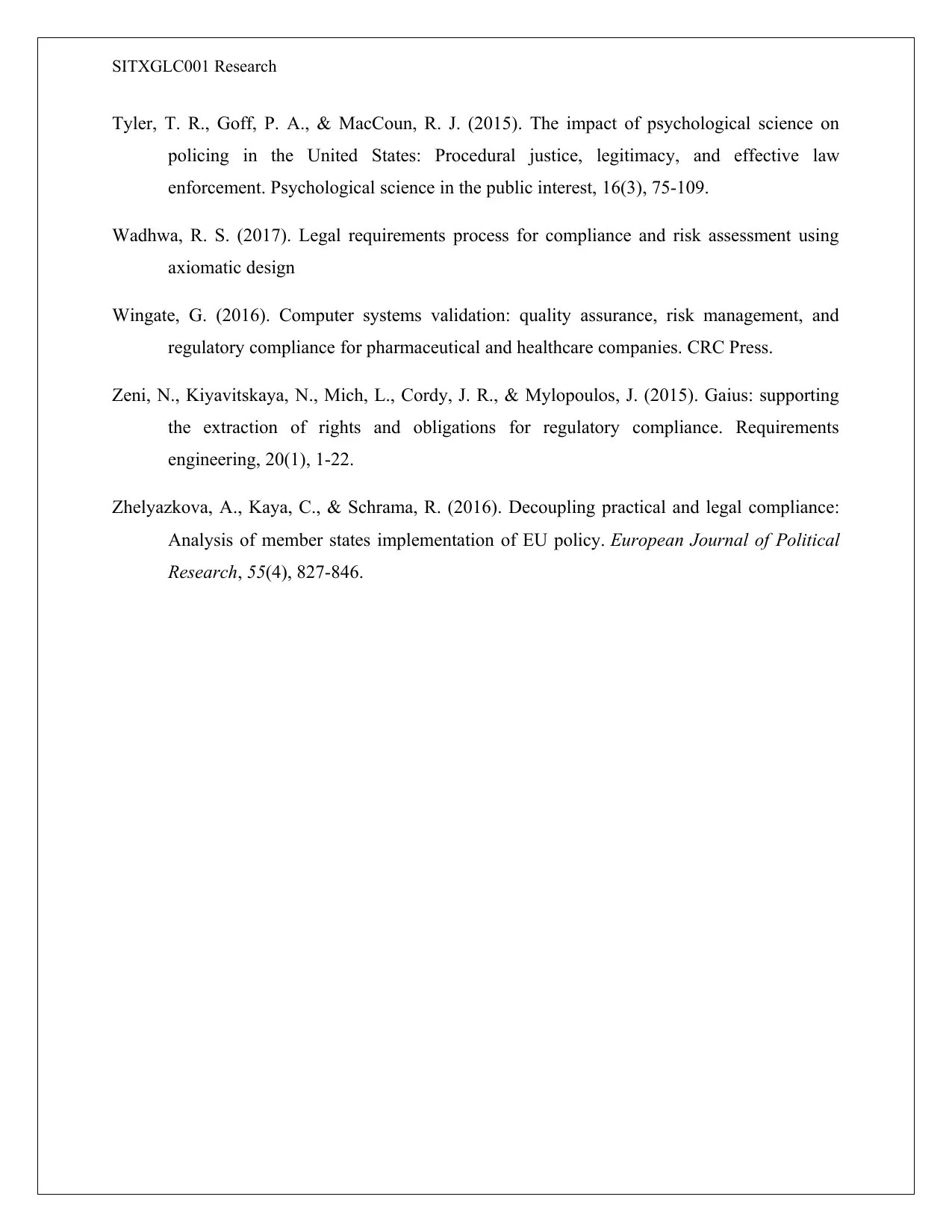
SITXGLC001 Research
Tyler, T. R., Goff, P. A., & MacCoun, R. J. (2015). The impact of psychological science on
policing in the United States: Procedural justice, legitimacy, and effective law
enforcement. Psychological science in the public interest, 16(3), 75-109.
Wadhwa, R. S. (2017). Legal requirements process for compliance and risk assessment using
axiomatic design
Wingate, G. (2016). Computer systems validation: quality assurance, risk management, and
regulatory compliance for pharmaceutical and healthcare companies. CRC Press.
Zeni, N., Kiyavitskaya, N., Mich, L., Cordy, J. R., & Mylopoulos, J. (2015). Gaius: supporting
the extraction of rights and obligations for regulatory compliance. Requirements
engineering, 20(1), 1-22.
Zhelyazkova, A., Kaya, C., & Schrama, R. (2016). Decoupling practical and legal compliance:
Analysis of member states implementation of EU policy. European Journal of Political
Research, 55(4), 827-846.
Tyler, T. R., Goff, P. A., & MacCoun, R. J. (2015). The impact of psychological science on
policing in the United States: Procedural justice, legitimacy, and effective law
enforcement. Psychological science in the public interest, 16(3), 75-109.
Wadhwa, R. S. (2017). Legal requirements process for compliance and risk assessment using
axiomatic design
Wingate, G. (2016). Computer systems validation: quality assurance, risk management, and
regulatory compliance for pharmaceutical and healthcare companies. CRC Press.
Zeni, N., Kiyavitskaya, N., Mich, L., Cordy, J. R., & Mylopoulos, J. (2015). Gaius: supporting
the extraction of rights and obligations for regulatory compliance. Requirements
engineering, 20(1), 1-22.
Zhelyazkova, A., Kaya, C., & Schrama, R. (2016). Decoupling practical and legal compliance:
Analysis of member states implementation of EU policy. European Journal of Political
Research, 55(4), 827-846.
1 out of 33
Related Documents
Your All-in-One AI-Powered Toolkit for Academic Success.
+13062052269
info@desklib.com
Available 24*7 on WhatsApp / Email
![[object Object]](/_next/static/media/star-bottom.7253800d.svg)
Unlock your academic potential
© 2024 | Zucol Services PVT LTD | All rights reserved.



